
If there was an example of a type of aircraft which shrunk the globe and brought air travel to the people, it was the Boeing Company SEVEN FOURTY SEVEN or as the public call it, the Jumbo Jet. To most though it’s the 747. For many airlines including our own QANTAS Airways, the 747 has been a vital aircraft to the airlines history, growth and became a favourite among air travellers form many decades. Sadly the sun is setting on passenger 747 operations with the airline.
Many of the worlds major airlines like Cathay Pacific, United and Singapore Airlines, where among some of biggest users of the type having withdrawn the ‘Queen of the skies’ from passenger service. The days where the Queen of the Skies was the mainstay of an airlines long haul fleet are now at an end. Prior to the COVID-19 pandemic, QANTAS was down to its final five examples.
Other International current major 747 operators prior to Covid-19 included:
Air China operate twelve Boeing 747-400s and 747-800s.
Air India operates four Boeing 747-400s
British Airways is the world’s largest operator of the Boeing 747, and has thirty six Boeing 747-400s in its fleet.
KLM Royal Dutch Airlines operated five Boeing 747-400s. With the airline officially retiring the type at the end of March 2020.
Korean Air has a fleet of twenty three Boeing 747s, which includes a mix of the older Boeing 747-400 version and the Boeing 747-800.
Germany’s carrier Lufthansa is the second-largest commercial operator of the Boeing 747. It has thirty two Boeing 747s in its fleet and predominantly uses the 747-8 model.

Lufthansa 747-8 D-ABYG seen at Tokyo’s Haneda Airport
Rossiya Airlines is a Russian airline, which operates nine Boeing 747-400s.
Thai Airways has seven Boeing 747-400s.
Virgin Atlantic operates seven Boeing 747-400s
When and if these aircraft all return to service post Covid-19 is a great unknown. Some airlines can’t afford the capitalisation for replacements. Others, which operate the current 747-8 version, will see them in service for some time yet.
Freighter versions of the type will still be seen at airports across the world. Boeing still maintains production of the 747 in the 8F variant. This much upgraded version of the type is required by various companies for its freight hauling abilities.
United Parcel Service operate twenty eight 747s currently with two more 747-8Fs due for delivery.
Cargolux the Luxembourg based Cargo airline operate thirty 747s which are a mix of 400Fs and 8Fs.
Air Bridge Cargo operate nineteen 747s in both 400F and 8F versions.
Nippon Cargo a division of Japan’s All Nippon Airlines operate thirteen 747s, in both the 400F and 8F versions.

Some of the NCA 747-8F Fleet at Narita Airport.
Cathay Pacific’s Cargo division operate some 20 747s. A mix of both 400Fs and 8Fs.
Atlas Air is the world’s largest cargo operator of the 747. Operating 47 of both 400Fs and 8Fs.
Another operator of the 747 are Governments and Militaries.
Imperial Iranian Air Force operate some very elderly 747’s, with some modified as air to air tankers. Exact numbers are hard to access, with at least one still airworthy.
United States Air Force operate several versions of the 747. This includes two of them in VIP configuration as the VC-25A. Or as most refer to them as Air Force One. These two aircraft replaced similar configured VC-137s (707s). Heavily modified these aircraft take the US President across the world.
The E-4B, which was formerly known as the National Emergency Airborne Command Post (referred to colloquially as “Kneecap”). This aircraft is now referred to as the National Airborne Operations Center (NAOC). Four of these aircraft are still in service today which are assigned to the 1st Airborne Command Control Squadron (1ACCS) of the 595th Command and Control Group at Offutt Air Force Base, Nebraska.
Under a $3.9 billion contract with Boeing, which is to modify two commercial 747-8s into the VC-25B Presidential aircraft. Replacing the older VC-25As. The modifications include, replacing the existing auxiliary power unit, two additional doors on the left side of the aircraft, one forward of the wing, and one behind the wing. The doors will come with retractable airstairs to allow the aircraft to emplane passengers and crew without needing to rely on ground-based staircases. Some additional modifications will be done to the aircrafts environmental controls, electrical power, water management, fuel system and engines.
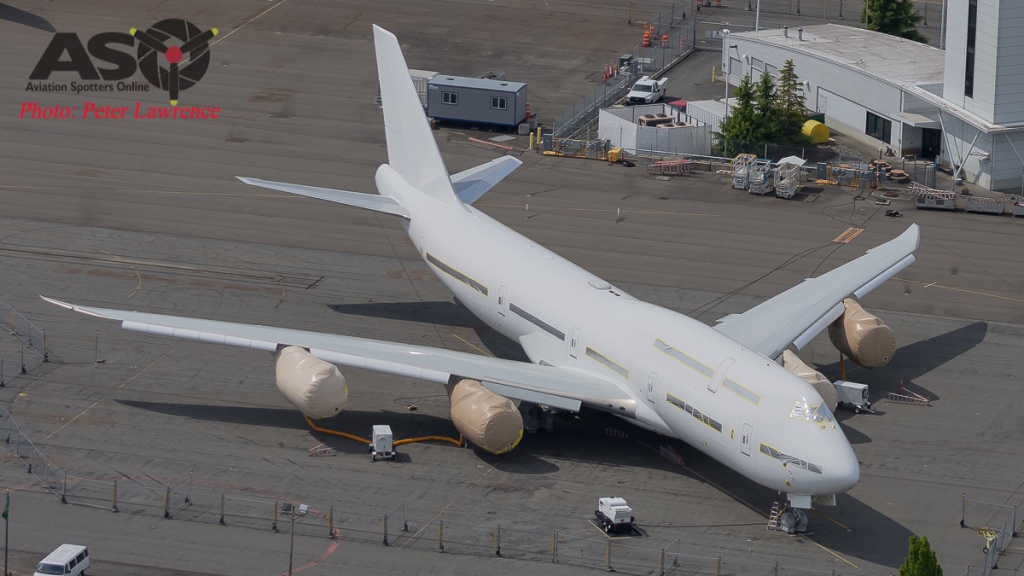
One of two 747-8s built and not delivered to Russian Airline, Transaero, these will become the USAF’s new VC-25B aircraft.
NASA is still a user of the 747. Its first two 747s were modified to carry the Space Shuttle orbiter. The first was a 747-100 (N905NA), and the other was a 747-100SR (N911NA). The first SCA carried the prototype Enterprise during the Approach and Landing Tests in the late 1970s. These were retired with the ending of Space shuttle missions.
Another variant still used by the space agency is a 747SP or SOFIA as it is known. This acronym stands for Stratospheric Observatory for Infrared Astronomy, NASA has the 747SP modified to carry a 2.7-meter (106-inch) reflecting telescope (with an effective diameter of 2.5 meters or 100 inches).
The QANTAS 747 story

Having flown on a QANTAS 747 in its 238, 338, 438 versions to destinations like Japan, Hong Kong and the USA, I’ll admit to having a real affinity with this airframe type. Now as the type winds down its passenger flying days in QANTAS colours, Aviation Spotters Online brings you the history on the types service in QANTAS Airways colours.

BOEING brings the Jumbo to the World
BOEING lost the United States Air Force CX-HLS (Cargo Experimental – Heavy Logistics System) contract to Lockheed and the C-5 Galaxy. Boeing then turned the attention to the commercial airlines and adapted its design to airline requirements. Initial work focused on an aircraft with a maximum weight of 600,000 lb and able to fly some 430 passengers.
In 1965, Joe Sutter was transferred from Boeing’s 737 development team to manage the design studies for the new airliner, already assigned the model number 747. Joe began a design study with Pan Am and many other airlines, to better understand their requirements for a larger airliner. Joe Sutter, the chief engineer behind the design and building of the type sadly passed away in 2016 ( See our tribute here: Mr 747 http://aviationspottersonline.com/mr-747-joe-sutter-the-man-behind-boeings-queen-of-the-skies-passes/)
On the 13th of April 1966, the manufacturer and PAN AM announced the launch of the type to the world with the airline ordering twenty five of the new aircraft dubbed the 747. Additional orders came in from Japan Airlines (JAL) and Lufthansa (Germany) and on the 25th July 1966, Boeing began construction of the first aircraft. This aircraft wasn’t a prototype and had been produced as a production ready airframe for Boeing as a demonstrator to the world’s airlines. The aircraft quickly earned the name ‘Jumbo Jet’ by the worlds press owing to the size of the aircraft compared to the then current aircraft types then in service across the world. Ironically the first aircraft N7470 was to continue to serve with Boeing as a testbed for 747 systems improvements and new engine developments for other Boeing commercial jets, including the Boeing 777 engine program.
Into production
Boeing did not have a factory large enough to assemble the aircraft so to solve this, they chose to build a new one. The company scouted locations in approximately 50 cities, before deciding to build the new factory some 30 miles (50 km) north of Seattle on a site adjoining a military base at Paine Field near Everett, Washington. Boeing purchased the 780-acre (320 ha) site in June 1966.
The site required more than four million cubic yards (three million cubic meters) of earth had to be moved. The timeline was so small that the 747’s full-scale mock-up was built before the factory roof above it had been completed. Even today the factory is the largest building by volume ever built, and has been substantially expanded several times to permit construction of other models of Boeing’s wide-body commercial jets.
Roll out and first flight
On September 30, 1968, the first 747 was rolled out of the massive Everett assembly factory to be presented to the world’s press and representatives of the 26 airlines that had ordered the 747. During the following months, preparations and tests were made for the first flight. This taking place on February 9, 1969, with test pilots Jack Waddell and Brien Wygle at the controls and Jess Wallick at the flight engineer’s station. Despite a minor problem with one of the flaps, the flight confirmed that the 747 handled extremely well. The 747 was found to be largely immune to “Dutch roll”, a phenomenon that had been a major hazard to the early swept-wing jets.
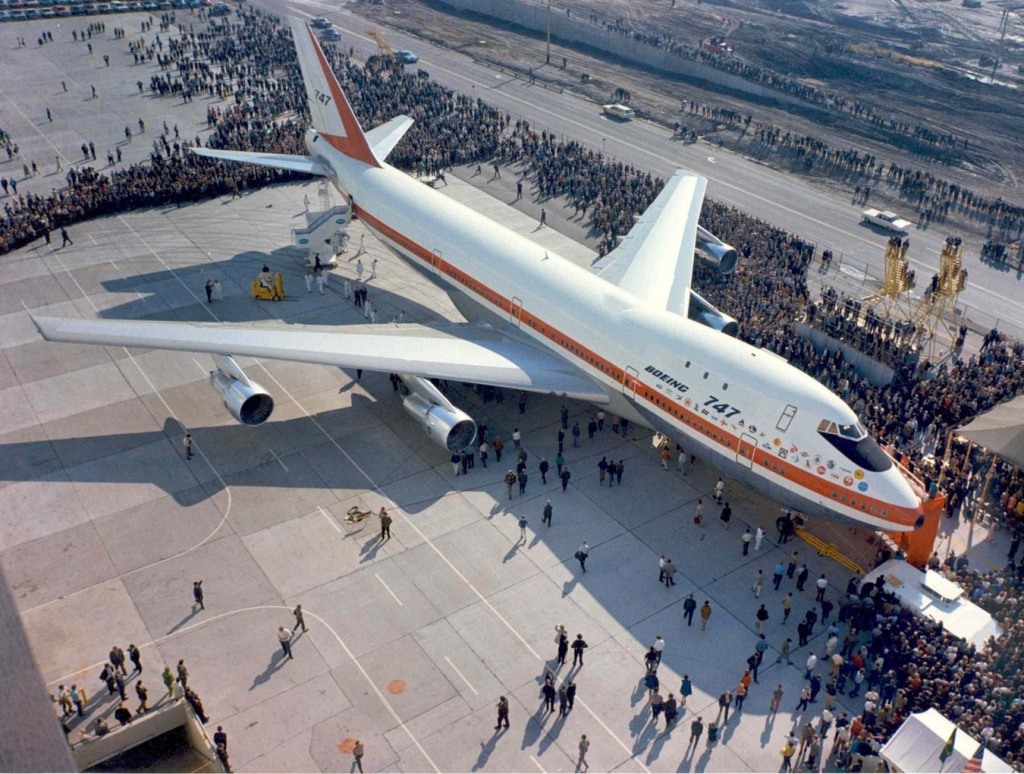
747 number one, N7470 City of Everett,on its roll out ceremony. (Image Boeing Collection)

N7470 City of Everett, on a test flight. (Image Boeing Collection)
QANTAS OPERATIONS:
QANTAS will retire the 747 from airline service and with a remarkable admiration of the type. The type serving since the first example, VH-EBA ‘City of Canberra’ a 747-238B was delivered in 1971. A remarkable 49 years of service in six distinct versions. QANTAS has flown and operated the 238B (SCD), SP-38, 238B, 338, 438 and 438ER. Also including some leased 100 series versions broken down into the following numbers:
| BOEING SUB TYPE | NUMBER OPERATED |
| BOEING 747SP-38 | TWO |
| BOEING 747-238(SCD) | THREE |
| BOEING 747-238 | NINETEEN |
| BOEING 747-338 | SIX |
| BOEING 747-438 | TWENTY ONE |
| BOEING 747-438ER | SIX |
| BOEING 747-4H6 | TWO |
| BOEING 747-436 | ONE |
| BOEING 747-48E | ONE |
| BOEING 747-123 | ONE |
| BOEING 747-130 | ONE |
| BOEING 747-21AC | ONE |
| TOTAL | SIXTY THREE |
Noteworthy QANTS 747 achievements
- QANTAS was the first airline to introduce the 747-200B version into airline service
- First airline to introduce Business class with the introduction of the 747
- On December 29 1974 VH-EBB (747-238B) took off from Darwin with 674 passengers being evacuated after Cyclone Tracey
- Became the worlds only 747 airline for a period between 1979 and 1985
- Two Aboriginal schemes were flown on VH-EBU ‘Nalanji Dreaming’ and VH-OJB ‘Wunala Dreaming’ a second version ‘Wunala Dreaming’ on VH-OEJ
- VH-OJA set a record for the longest nonstop flight which took 20 hours and nine minutes.
- Qantas was the only airline to introduce the 747-400ER into passenger service
- The 747 has flown for 49 years in passenger operations with QANTAS
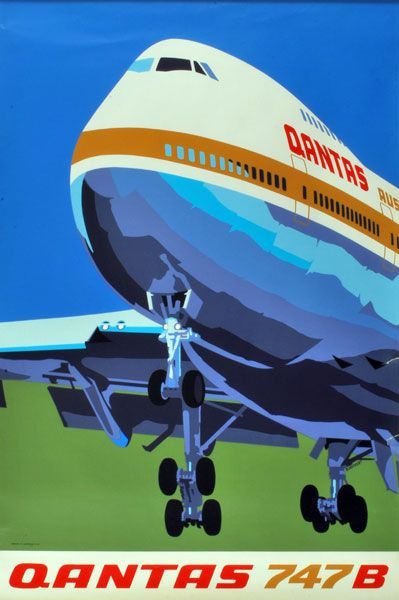
QANTAS orders the 747
It was in the late 1960’s that QANTAS had begun evaluating the need for bigger aircraft, the Boeing 747. Qantas decided to retain its 21 707s then in service and wait for the more advanced B series. With better powered engines than on the earlier 100 series this proved to be a wise decision.
QANTAS ordered the Boeing 747 in 1967 with four of the type at a then cost of $21 million each. Further expendeture for the construction of a new hangar, engine test cell and support equipment and spare parts for the new type accounted for another $135 million. A huge investment in 1967 by any means. QANTAS had also put commitments down at the same time for the six Boeing SST and four Concordes. Which as time went by none of which were delivered to the airline.
The 200 series version had an improved take off performance, more range and an increase in take off weight. All of these improvements were of real benefit to the airline, and its operations of the type from Australia.
Another notable change to the order was that the first QANTAS aircraft line number 147 was the first airframe to be modified with ten upper deck windows unlike the previous airframes before it which only had three.
QANTAS required the room for an increase in passengers on the upper deck. Up from the previous eight in the three window version to 16 in the QANTAS ten window version.
Delivery of the first, of many
It was on the 16th of August 1971 that the airline was to change its operations forever. Aircraft VH-EBA a 747-238B, ‘City of Canberra’ touched down at Mascot Airport (Sydney) under the command of Captain R Probert with along with B. Fawcett, H. G. Manly and Flight Engineer B.G. Costello. The flight route from Seattle took them to San Francisco, Honolulu and finally Sydney.
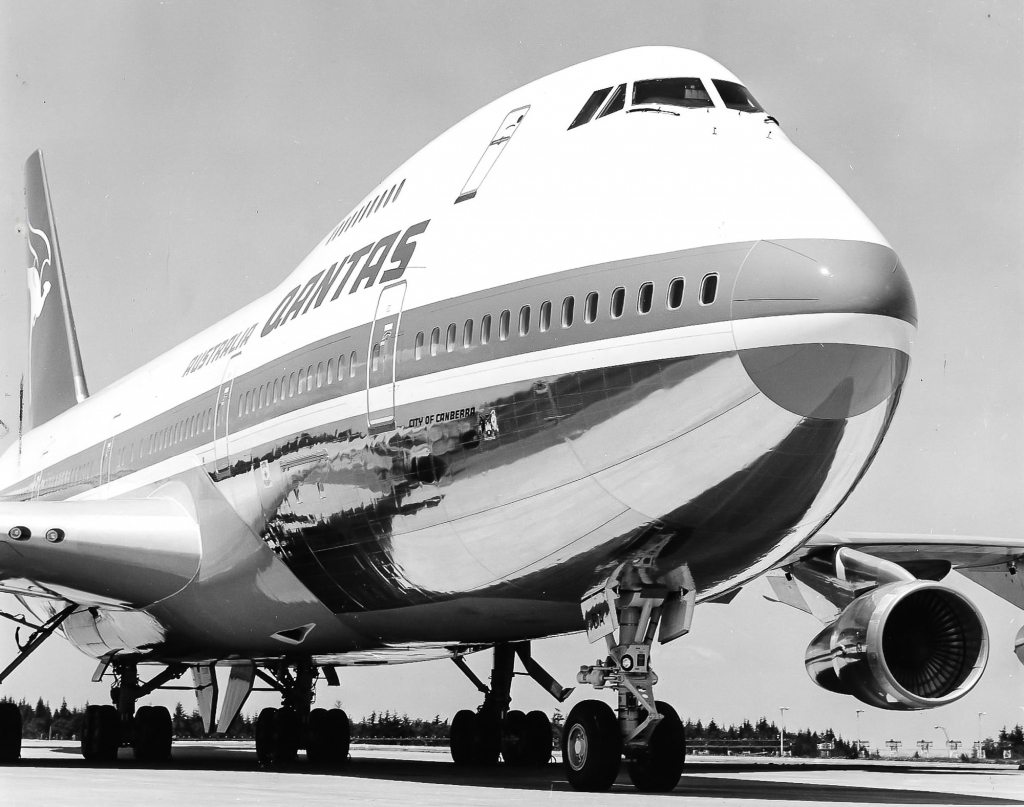
Factory fresh VH-EBA after its delivery to QANTAS. (Image courtesy of Historic Australian Aircraft)
The second aircraft VH-EBB named the ‘City of Melbourne’ followed on the 29th August crewed by A. R. Horne and E. Robinson who routed the aircraft on a similar route as EBA previously, thought the aircraft arrived in Melbourne rather than Sydney.
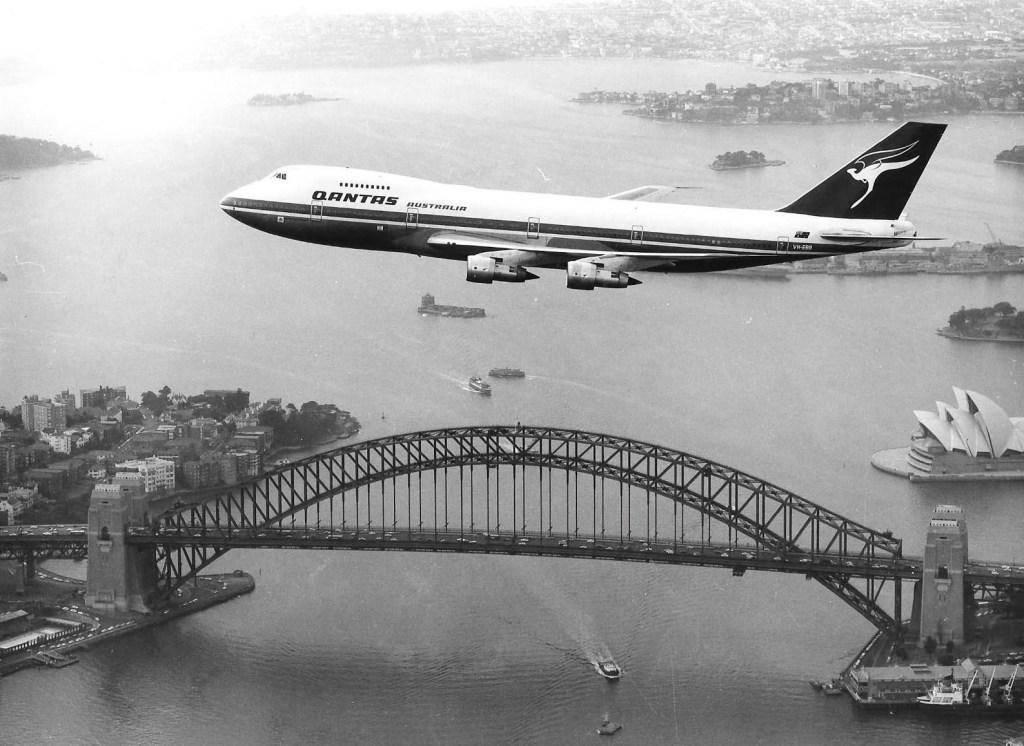
VH-EBB overlies the Sydney Opera House. (Image courtesy of Historic Australian Aircraft)
747-238B enters service with QANTAS
The 747-238B entered service with QANTAS at a turbulent time across the world. Trouble in the Middle East, an economic downturn in the US and Australia. This was coupled with Australian and US authorities which had come to logger heads over the increase in services between the USA and Australia. A ban would ultimately come into effect where no new services between the USA and Australia saw QANTAS abandon services to San Francisco due to the ban.

VH-EBA is seen on a pre-delivery flight. (Image courtesy of Historic Australian Aircraft)
This saw QANTAS revise its 747 introduction and look to routes where the type would be successful. Singapore and the United Kingdom ( Kangaroo Route) were introduced and the aircraft was proving its worth. QANTAS was back at the order table with Boeing soon to add further aircraft although with a difference.
The Airline ordered the Combi version, which could carry 28.8 tonnes of cargo on the main deck with 270 passengers also able to be seated.
QANTAS was to order three of the Combi model with VH-ECA the ‘City of Sale’ delivered in October 1977. This was also the last 747 ordered new by QANTAS with the Pratt & Whitney JT9D engines. the next two aircraft, VH-ECB and ECC were equipped with the Rolls Royce RB211-524B2s. The Combis were kept busy flying freight and passengers to destinations like San Fransicso, Frankfurt, Hong Kong, Tokyo, Los Angeles and Auckland.
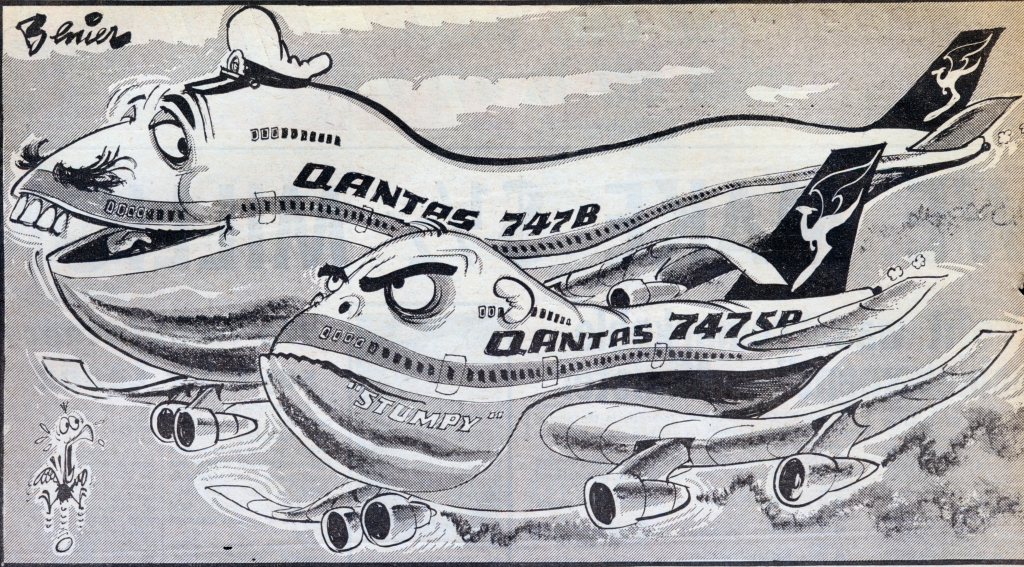
QANTAS caricature done for the introduction of the SP or ‘Stumpy’ as it was known. (QANTAS Newsroom Image)
Freight included on some runs to the US, DC-9 and MD-80 elevator kits which were being assembled at the time by the Australian subsidiary of Hawker de havilland.
By 1979 the airline had sold off its remaining 707 aircraft and became the worlds only all 747 airline. Some seventeen of these aircraft were now in the airlines fleet. In the same year Qantas launched the world’s first Business Class service. This title continued until 1985 when the airline introduced Boeing 767-238ER.
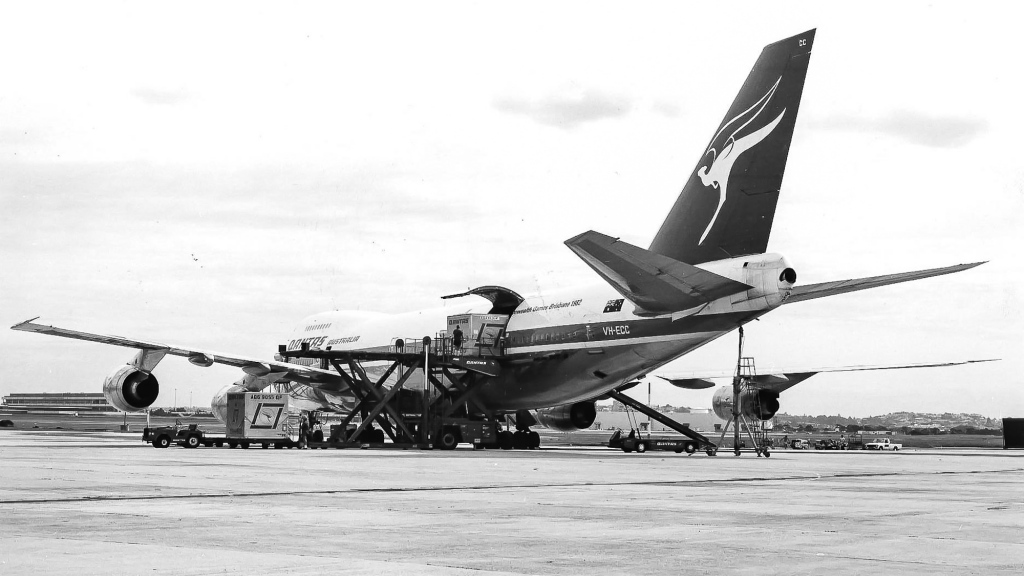
VH-ECC, was 747-238B-SCD. One of three in the QANTAS Fleet. (Historical Australian Aircraft)
In the 1980’s the airline produced an add which showed the 747-238 in all its glory.
The QANTAS PR team went into overdrive to promote the JUMBO to the traveling public. Highlighting the room and cocktail lounge onboard the aircraft. Below are some examples of the years the airline has used to promote 747 services. As the examples below show, all aspects of the 747 were highlighted to the public. From the spacious first class lounge, to overseas destinations, like Britan and San Francisco. The 747 was the heart and soul of the airline for many years.
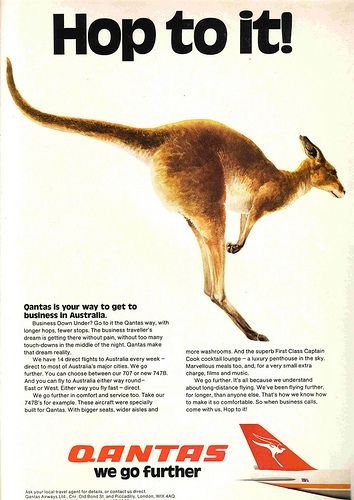
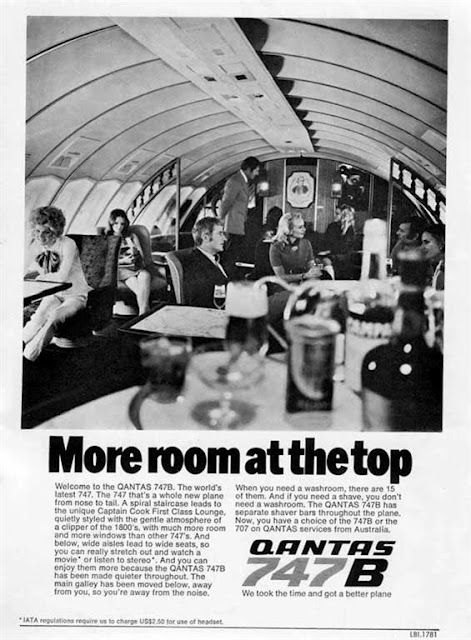
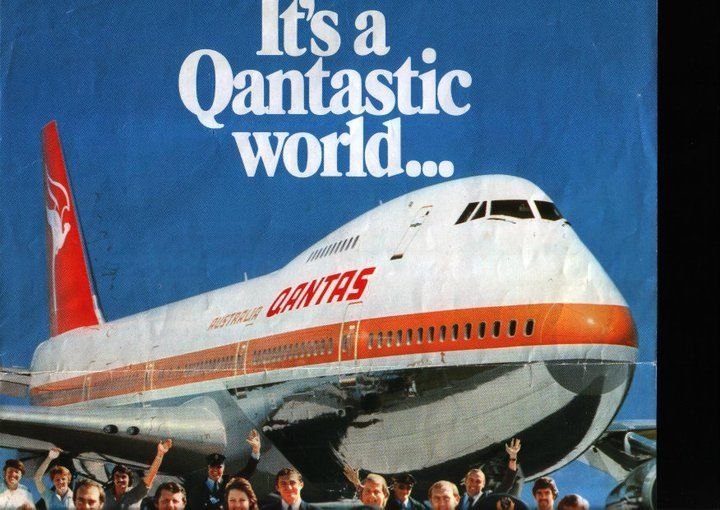


747SP
A special variant to enter service in the early 1980’s was the 747SP or Special Purpose. The airline ordered two of these aircraft with VH-EAA ‘City of Gold Coast/Tweed being delivered in January 1981 followed by VH-EAB ‘City of Winton’ in August 1981. These two aircraft were two of only five Rolls Royce RB211-524B2s engine equipped aircraft built by Boeing. The SP was unique as it performed well in short field/long range role it was designed for.

A QANTAS 747SP prepares to touch down. (Image from Historic Australian Aircraft)
The SPs were seen regularly operating into Wellington Airport in New Zealand. The airport had a very short runway something the SP was able to capitalise on. The service went onto become a great success before this flight was eventually taken over by the 767-238ER. Qantas then placed the 747SP on services to the USA with three flights a week between San Fransisco and Los Angeles.
By 1994, a change of name and the tail saw the aircraft operate for Australia Asia Airlines (so to keep the Chinese Government on side) to Taipei. When not in operation for Australia Asia the aircraft were used to operate QANTAS services to Taiwan.
VH-EAA operated its final Qantas revenue service Singapore – Jakarta – Sydney as QF42/22 on February 23 2002. It was then flow to Marana for storage. It was then broken up in 2002.
VH-EAB operated its last service as QF004/23 on November 24 2001 where it went to Marana and was broken up as well in 2002.

VH-EAA is seen taxing, (QANTAS Newsroom Image)

VH-EAA is seen at Melbourne Airport (Ian Gains Image)
747-338ER
The airline introduced the 747-338 in September 1984 with VH-EBT arriving into Australia on November 16, 1984. Named ‘City of Canberra’ it was the first of six examples which went to serve the airline. Three of these eventually were leased to Japan Air Lines (JAL), for a period between 1992 and 1994.
The 338 series also spent time in the Garuda Airlines livery where they flew Haji’s Pilgrimage flights from Indonesia to Saudi Arabia. This also saw 483 seats installed for these operations. The 338s were to start to leave the fleet in 2007.

VH-EBW as operated by QANTAS. (Image courtesy Historic Australian Aircraft)
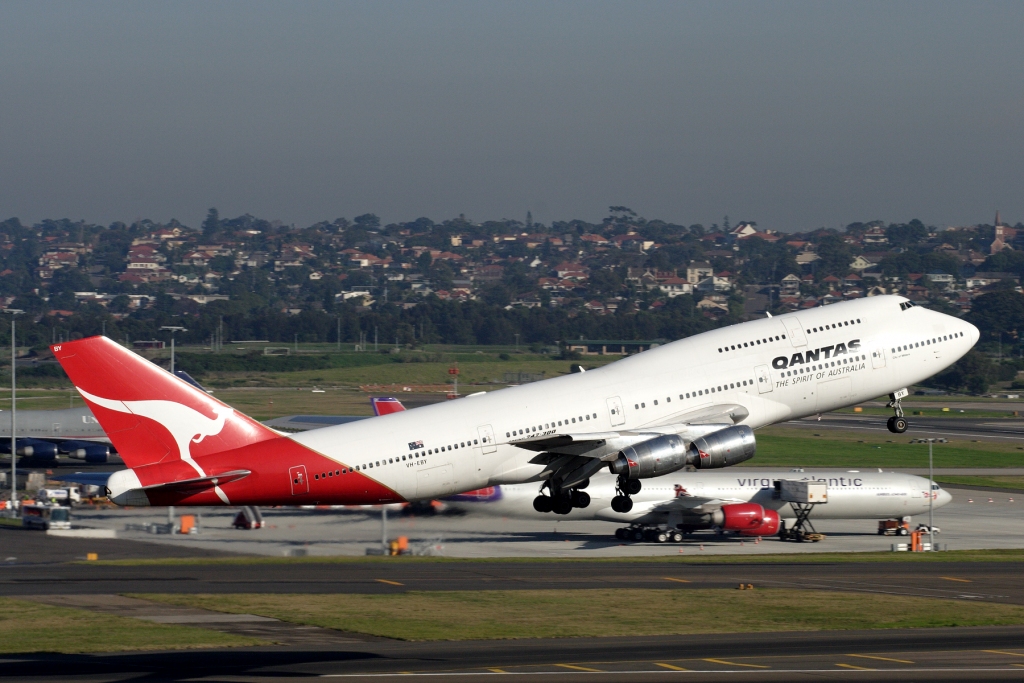
VH-EBY departs Sydney Airport (QANTAS Newsroom Image)

QANTAS 747 were a regular feature at Australian Airshows, as evidenced by one of the 747-338s landing at the 1988 Bicentennial Airshow at RAAF Richmond. (Historical Australian Aircraft)
747-438ER
QANTAS kept its commitment to the 747 when it placed an order for the then latest version of the aircraft. An initial order for, four 747-400s was placed on March 2, 1987. In August 17 1989 after flying direct to Sydney from London VH-OJA ‘City of Canberra’ arrived after its record nonstop flight The 18,001km flight, under the command of Captain David Massy-Greene, took 20 hours, nine minutes and five seconds and established a new world distance record for a commercial aircraft.
Eventually twenty one of the 438 variant would go to serve the airline. From VH-OJA through to VH-OJU. VH-OJQ was noteworthy as the 100th Boeing airliner delivered to QANTAS. Three more 747s of the 400 series were added by QANTAS.
The first VH-OEB ( a 747-48E) a was originally ordered and delivered to Asiana Airlines of Korea as HL-7416.Delivered to the airline in 1993 it was sold to QANTAS in 1998 later being named ‘Phillip Island’.
VH-OEC (a 747-4H6) became the second aircraft. It was ordered and delivered to Malaysia Airlines as 9M-MHN. Joining the QANTAS fleet in 1998.
The third aircraft also came from Malaysia Airlines where is previously flew as 9M-MHO. Again it joined the QANTAS fleet in 1998 as VH-OED later named ‘Kangaroo Island’.
QANTAS were very proud of their new 747-400s, so the airline produced an add to showcase the types introduction.
747-438ER
The first of six Boeing 747-438ERs was ordered by Qantas Airways on November 29th 2001. Rolling off the production line at Everett in the Boeing House livery as ‘N6018N’ on June 6th 2002. This was the first 747-400ER (Extended Range) built by Boeing. Powered by General Electric GE CF6-80C2B5 engines, it was delivered to QANTAS as VH-OEE as was delivered to the airline at Avalon Airport in 2002.
The final aircraft VH-OEJ was the 142nd Boeing airliner delivered new to Qantas Airways and the 57th and last Boeing 747 delivered to Qantas. It was delivered as the second version of ‘Wunala Dreaming’. Repainted by the airline in 2012 it has become somewhat a logo jet with promotions such as ‘Proudly Supporting the Socceroos’ and ‘2016 Olympic Games’ titles featuring on the aircraft.
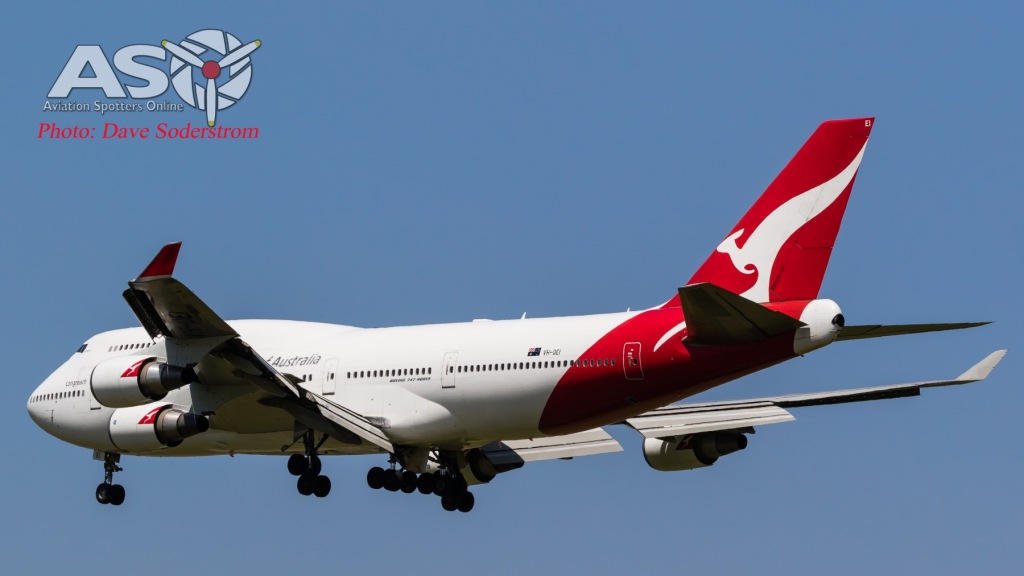
Retirement for the ER series started the final chapter in the passenger versions of the QANTAS 747 history.
VH-OEF operated its final revenue service Sydney (Kingsford Smith) – Los Angeles as QF99 on February 09, 2020. It was withdrawn from service at Los Angeles and prepared for sale with the QANTAS titles removed. The aircraft was ferried from the QANTAS jet base at Los Angeles to San Bernardino as QF6021 on February 13, 2020.
The aircraft had flown 79,622.58 hours with 7,379 cycles. The engines were then removed at San Bernardino by Qantas engineers.
With the Airline celebrating its 100 years a new inflight safety ad has been produced as a tribute to the Airlines history. Of course the 747 along with many other unmistakeable types gets a unique mention.
Seating in a QANTAS 747
With the type due to retire at the end of 2020 QANTAS hasn’t preformed many upgrades to the seating on the airframes. QANTAS 747-400ER are currently in the 58J/36W/270Y configuration. This means there are 58 Business class flat-bed seats on the Upper and main decks, 36 Premium Economy seats and 270 Economy Class seats on this aircraft.
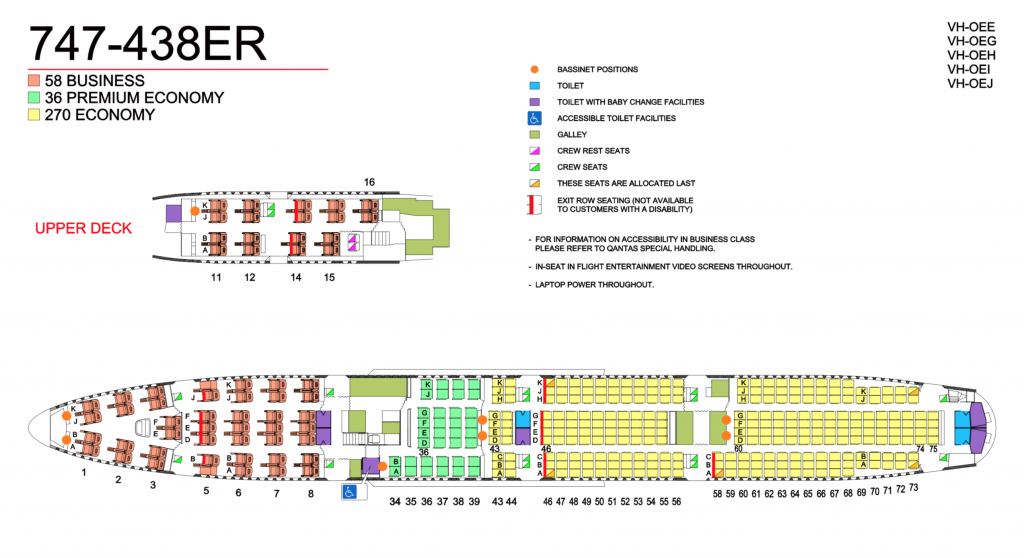
QANTAS 747s in the movies
Qantas 747s also made it into the movies. In the 1986 movie, Crocodile Dundee (Paul Hogan) playing Michael J. “Crocodile” Dundee, flies to New York courtesy of a 747-238B.
In the ABBA Movie which came out in 1977, there are some air-to-air & ground shots of a Qantas 747 at the beginning of the film.
And of course ASO’s resident videographer Mark Pourzenic, has documented the QANTAS 747 many times as seen in this compilation video above. Just listen to the music coming from those Rolls Royce engines!
Keeping the 747 flying
Being a type which flies long hours and operates around the world. The 747 like all travellers needs some down time to recoup and even be reconfigured to keep up with the evolving Airlines competing for flights for their customers. QANTAS has maintained the 747 at its Kingsford Smith sites in Sydney, with other overhauls and upgrades happening elsewhere too. The airline took the huge step to build a new maintenance facility at Los Angeles. The 5.7 hectare site is used to carry out maintenance checks on Qantas’ A380 and Boeing 747 aircraft during ground time in Los Angeles. It also supports the 787-9 Dreamliner.
The airline was aiming to upgrade its five ‘classic’ 747’s, outfitting them with refreshed first class suites, new business class and premium economy seats plus two new onboard lounges. With the aim to have that work completed by the end of 2020. The COVID -19 outbreak has seen the entire fleet parked up. The remaining four examples are stored at the airlines Sydney Mascot jet base.
QANTAS has gone to great lengths to keep their 747 fleet, this is evidenced by the huge work undertaken at QANTAS Engineering around Australia and overseas. The age of the aircraft, the number of hours it’s flown, the number of take-offs and landings, requirements by aviation regulators and our own policies determine when and what type of maintenance is undertaken. They are divided into three types of “checks” that bundle together hundreds of tasks – A Checks, C Checks and D Checks.
Regular line maintenance which includes inspecting things like wheels, brakes and fluid levels (oil, hydraulics) are done during transit checks. Plus, any running repairs that the aircraft tells us it needs through thousands of on-board sensors. Most aircraft would receive about 12 hours of line maintenance per week. These happen around the world and around the clock.
As this sequence of images below shows, VH-OJN is seen undergoing extensive maintenance and overhaul of the entire airframe. It was the 44th Boeing 747 delivered to QANTAS and carried the ‘City of Dubbo’ name. At the time the aircraft was undergoing a D check.
This is also known as a C4 or C8 check depending on the aircraft type. This check is performed every six years and the entire aircraft is basically dismantled and put back together. Everything in the cabin is taken out including the seats, toilets, galleys, overhead bins, so engineers can inspect the metal skin of the aircraft, inside out. The engines are taken off, and are overhauled as required.
The landing gear is removed and overhauled with the aircraft supported on massive jacks. All of the aircraft systems are taken apart, checked, repaired or replaced and reinstalled. Each D Check costs several million dollars and takes about three to six weeks, but it’s almost like a brand new plane by the end of it.
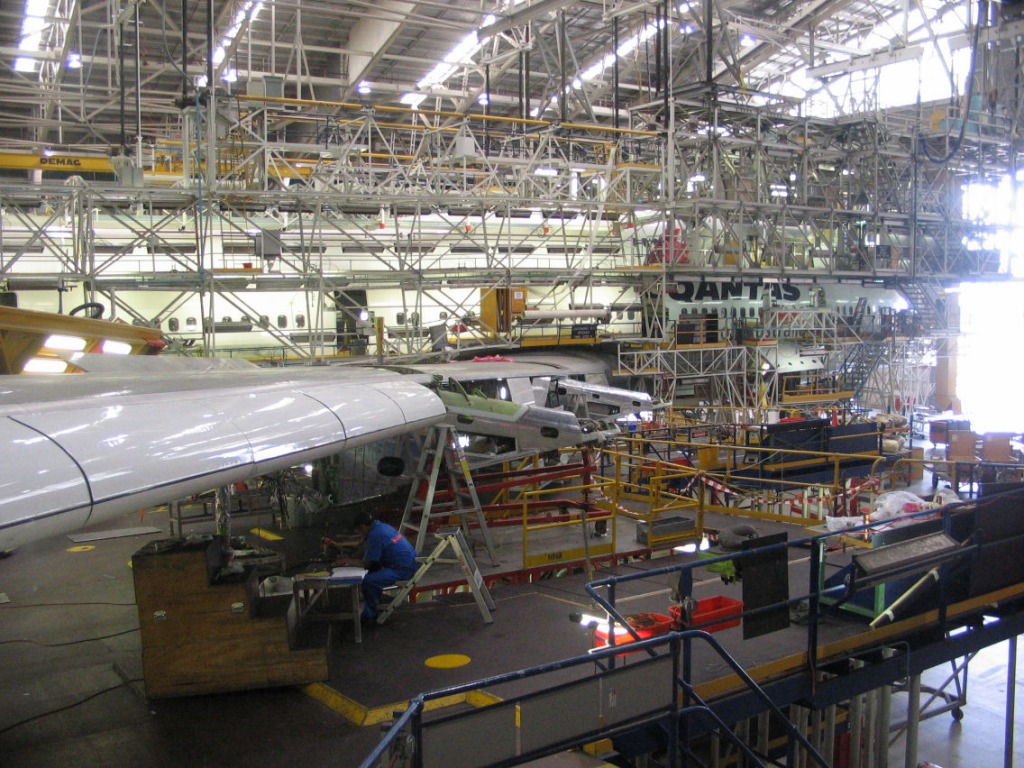
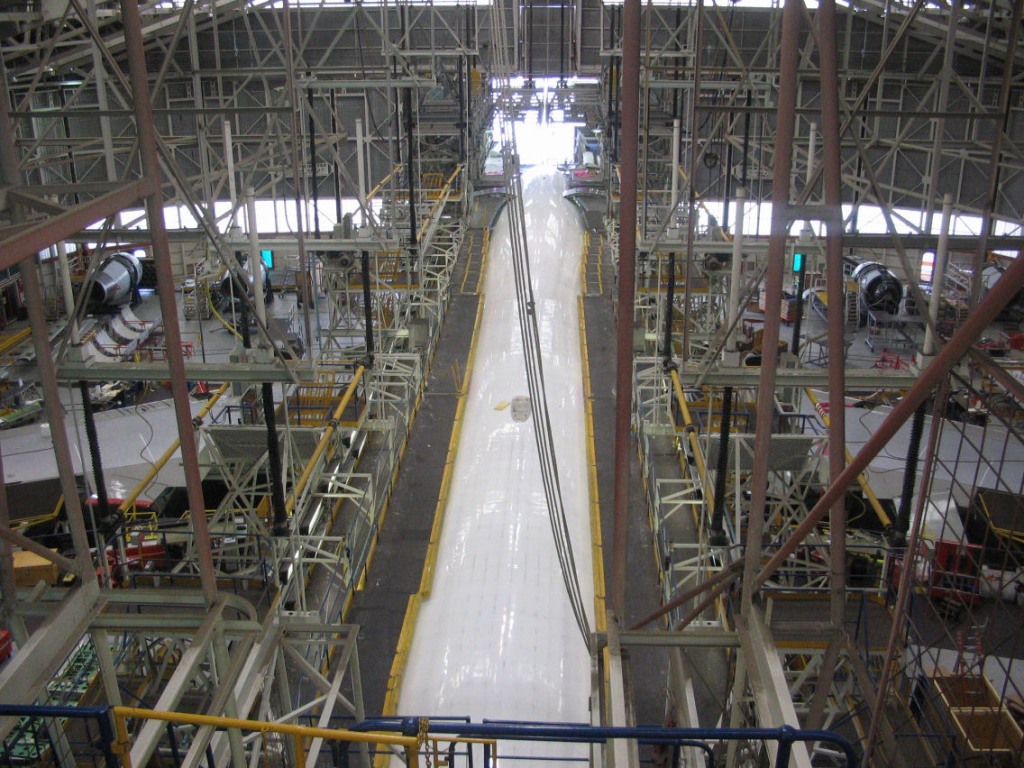
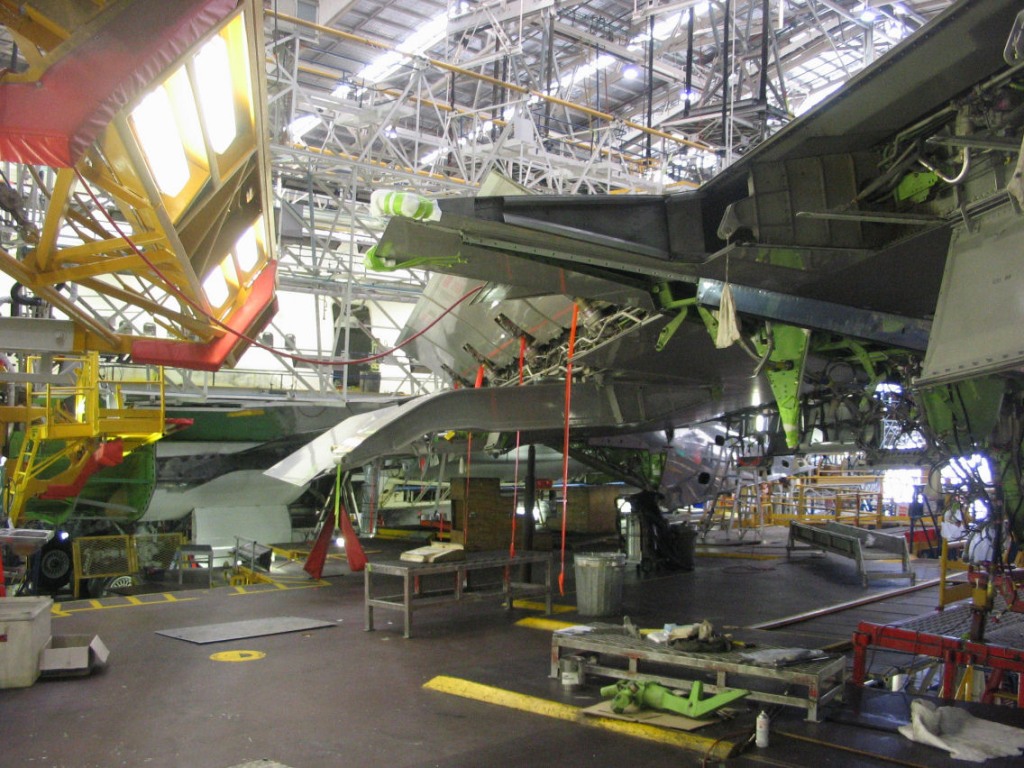

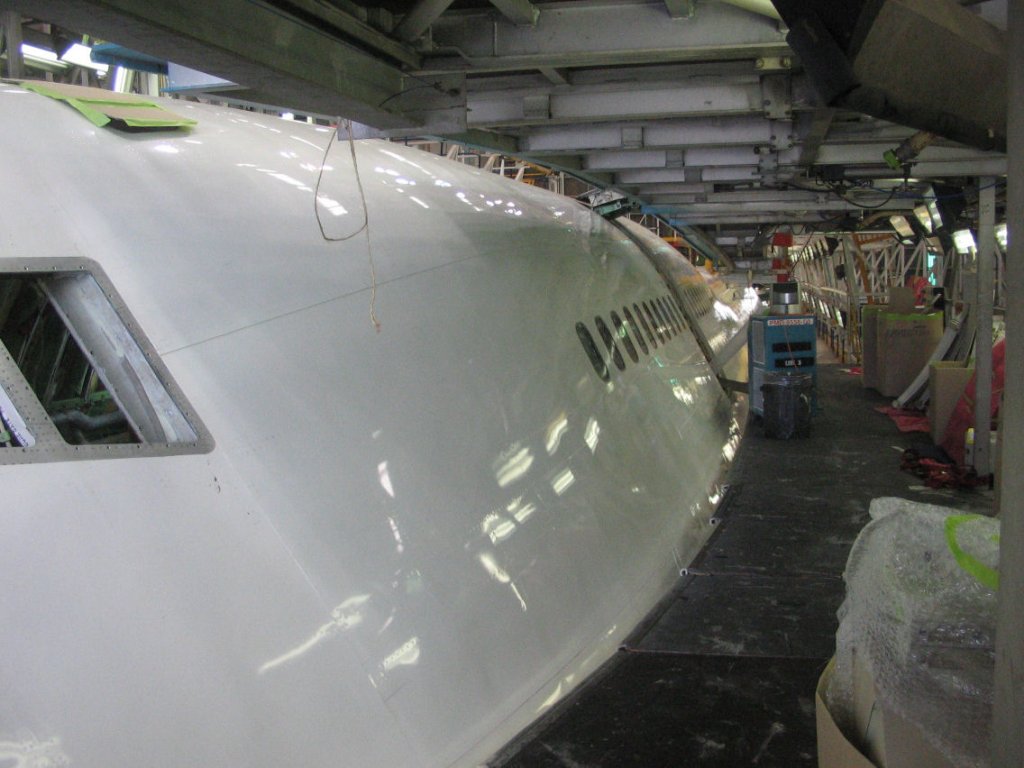
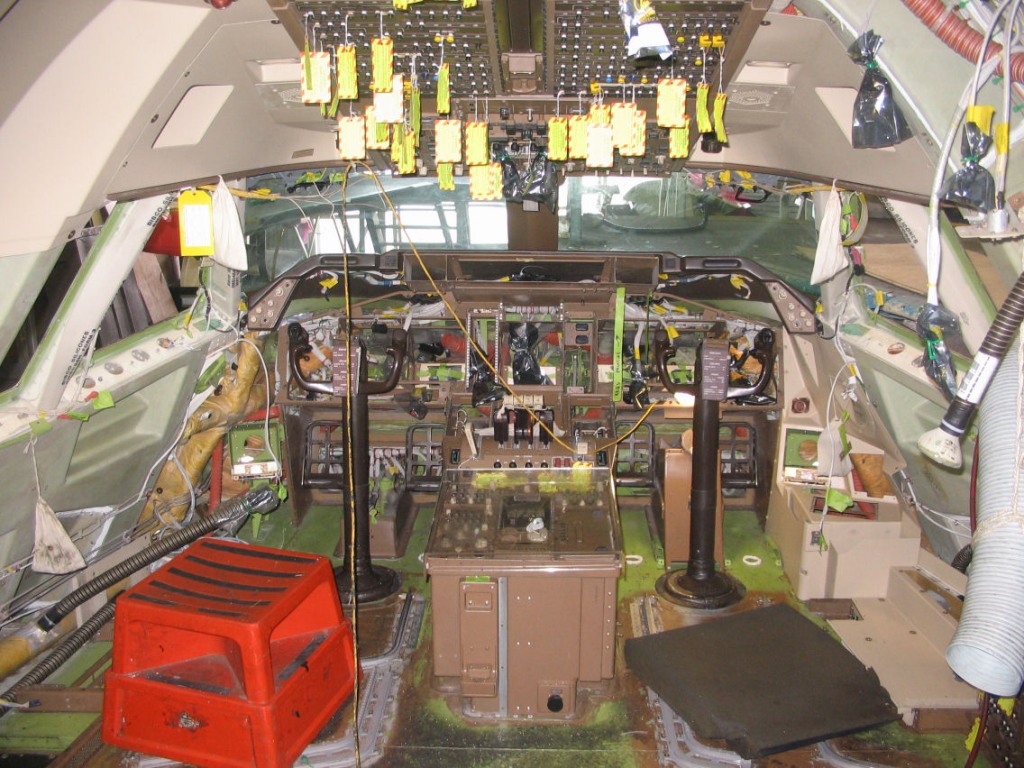

Photos of the 747 in QANTAS service
747-238 Series

VH-EBR about to land (Historic Australian Aircraft)
747-338ER Series
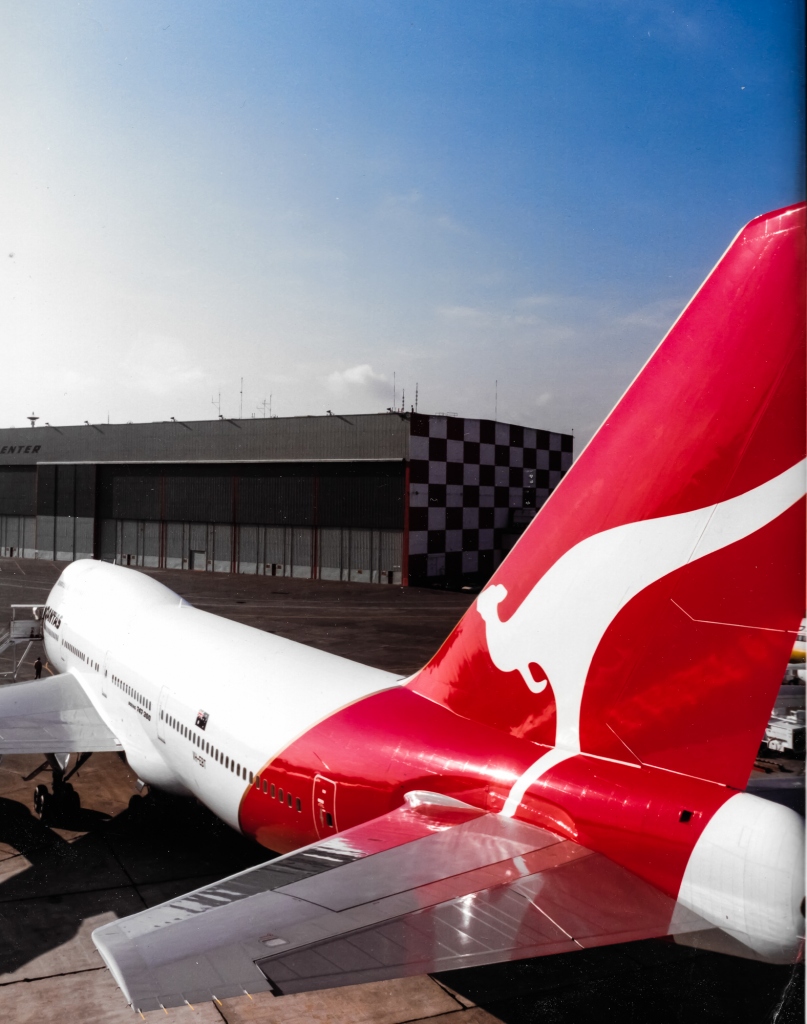
VH-EBT is seen before delivery to QANTAS at the Boeing Flight Centre at Everett. (Historic Australian Aircraft)
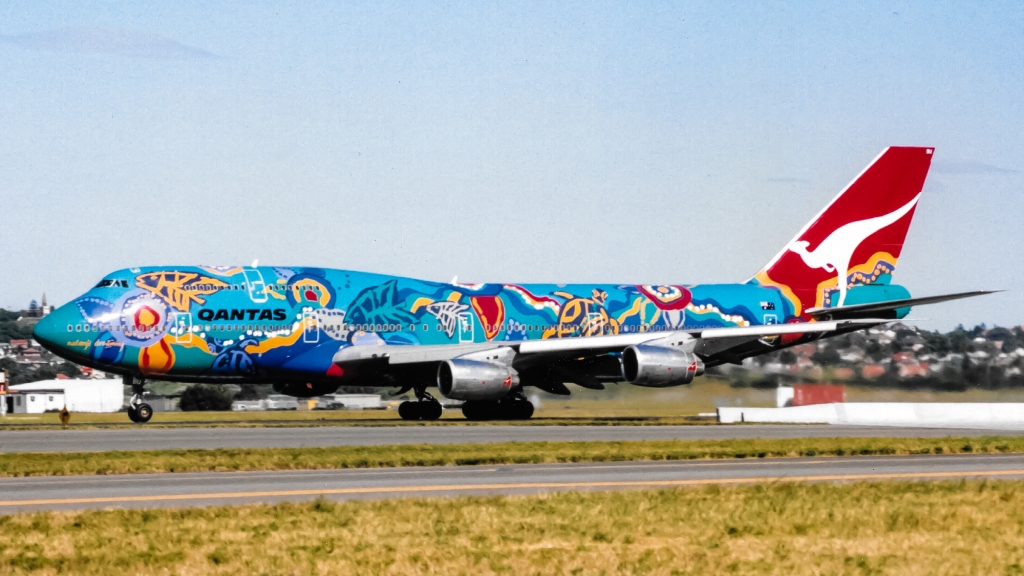
VH-EBU in its distinctive ‘Nalanji Dreaming’ livery (Historic Australian Aircraft)

VH-EBX seen on landing.
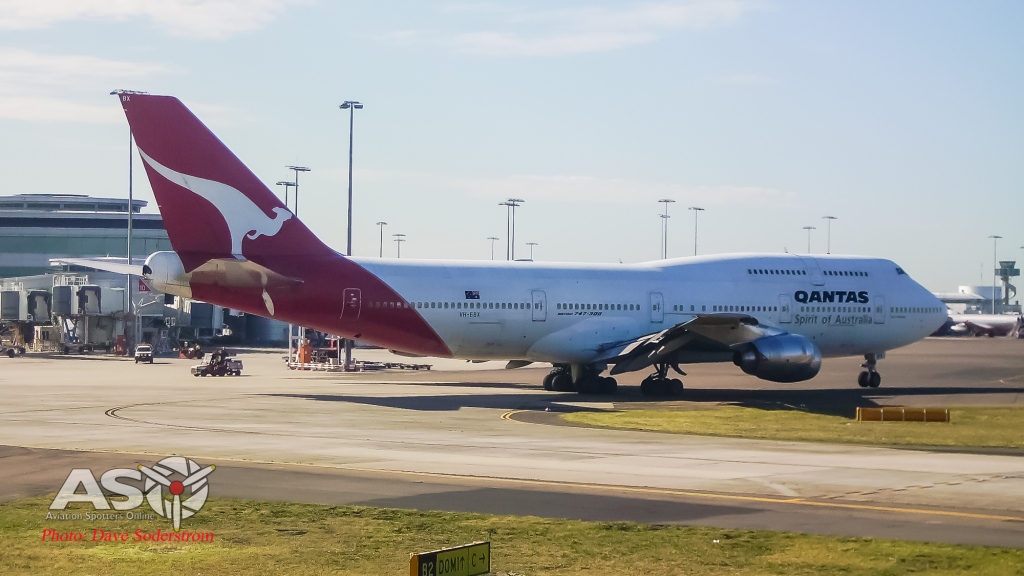
VH-EBX seen about to depart Sydney Airport

VH-EBY overflying the Avalon Airshow in 2005

747-438 Series
VH-OJA c/n 24354-731

VH-OJA touches down for at Illawarra Regional Airport in NSW. (QANTAS Newsroom Image)
VH-OJB c/n 24373-746.

Rolled out in the special ‘Wunala Dreaming’ aboriginal livery at Sydney in September 04, 1994. It was a very popular drawcard where ever it flew, as Evidenced here by a visit to Avalon Airshow.
VH-OJK c/n 25067-857
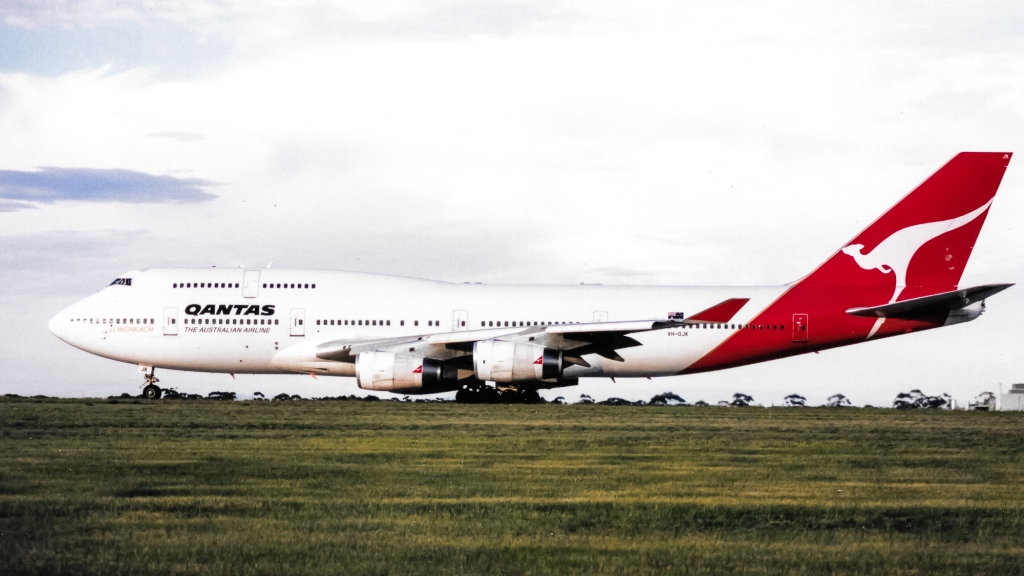
This aircraft was badly damaged when an oxygen cylinder ruptured in the forward cargo hold on July 25th 2008. It was operating service Hong Kong – Melbourne (Tullamarine) as QF30
VH-OJL c/n 25151-865.

VH-OJN c/n 25315-883
Seen at the 1992 Avalon Airshow, VH-OJN prepares to depart.
VH-OJO c/n 25544-894.

VH-OJP c/n 25545-916.
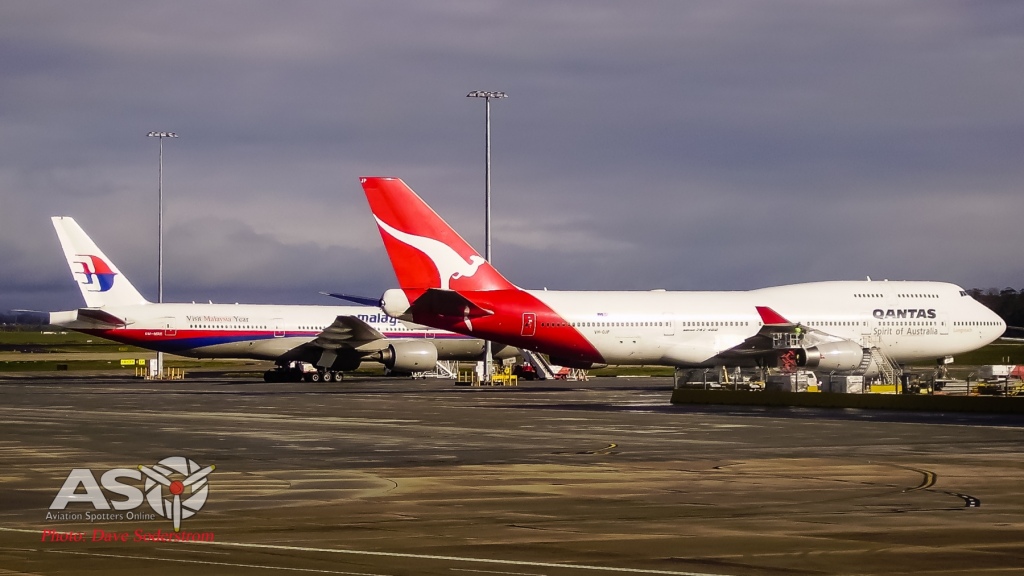
VH-OJT c/n 25565-1233.



VH-OJT passing through Darwin. Arriving as QF1364 from ADL and departed as QF6008 to SYD. It was the 50th 747 delivered to Qantas
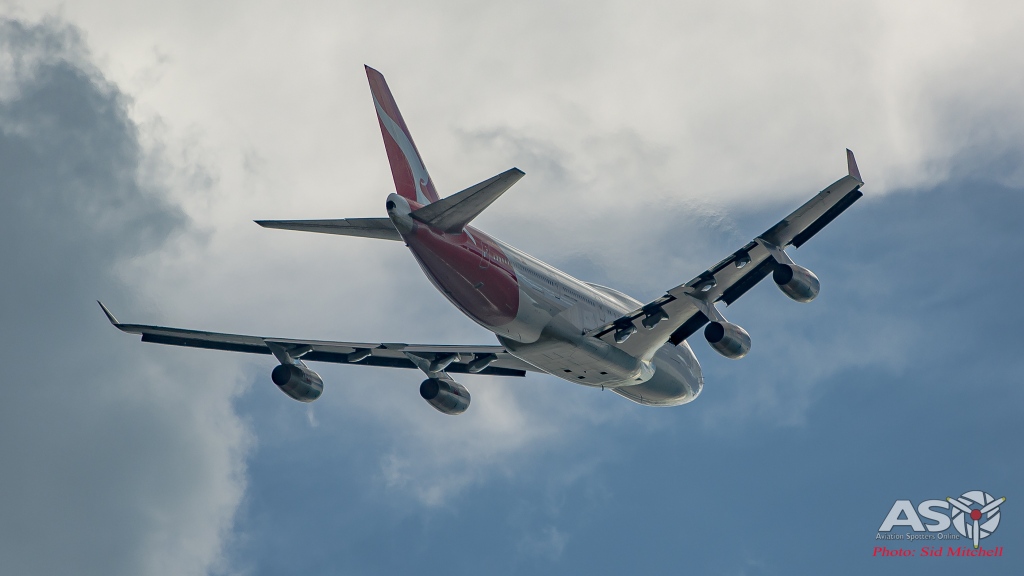
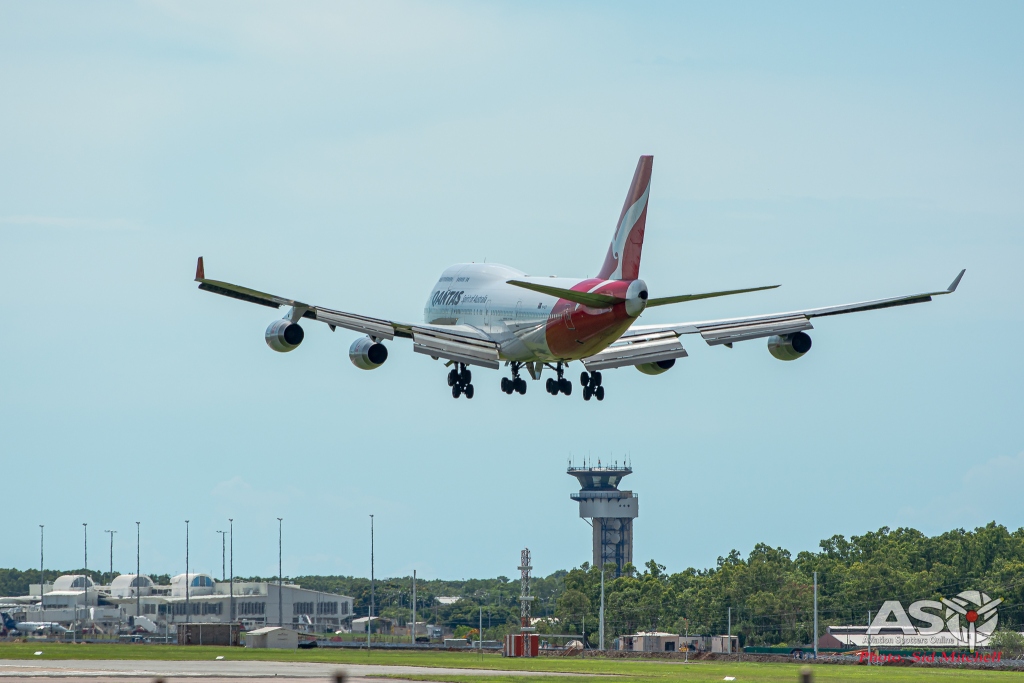
VH-OJU c/n 25566-1239.


VH-OJU is seen arriving at Avalon Airport, for display at the Australian International Airshow.
VH-OJU was a welcome arrival at the 2019 Australian International Air Show. Operating as flight QF1360 the flight which cost passengers, $747 dollars return, was put on by Qantas for the Rural Aid charity. The flight raised an incredible $138,000 for the charity.
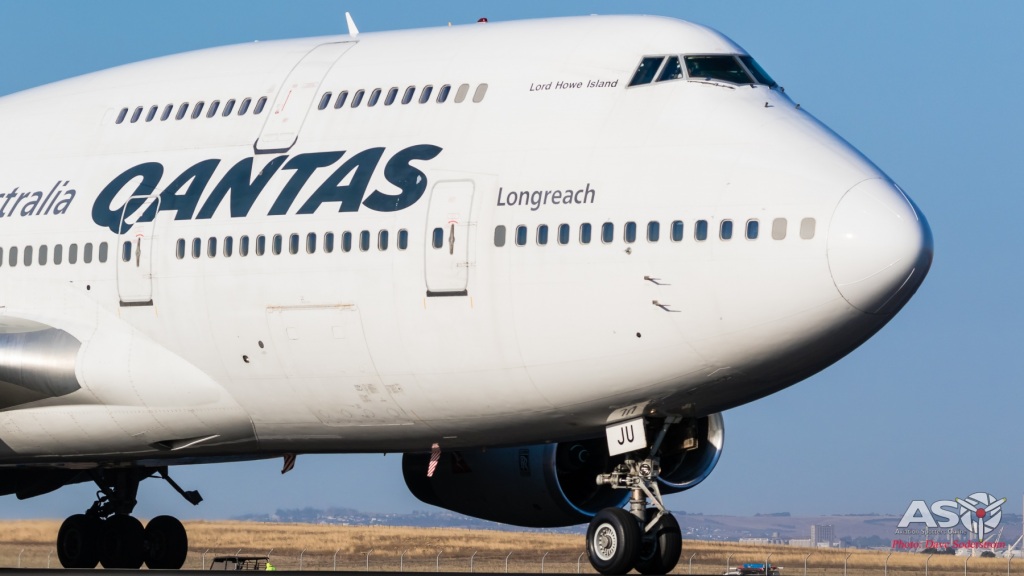
Another side story for VH-OJU, after its arrival at Los Angeles on completion of its final revenue service on October 13, 2019. The aircraft was prepared for delivery to engine manufacturer Rolls-Royce. Ferried from Los Angeles to Moses Lake (Grant County International) as QF6021 – October 15, 2019 by QANTAS flight crew, Capts David Bracewell, Robert Nelson, F/O Andrew Packwood, S/O Andrew Croker.
The aircraft was handed over to Rolls Royce at Moses Lake – October 15, 2019. The aircraft had flown 92,371 hours with 9,429 cycles on landing at Moses Lake. The aircraft was the last Rolls-Royce RB211 engined Boeing 747 in the QANTAS fleet. The airframe will be reconfigured for use as a flying engine testbed.
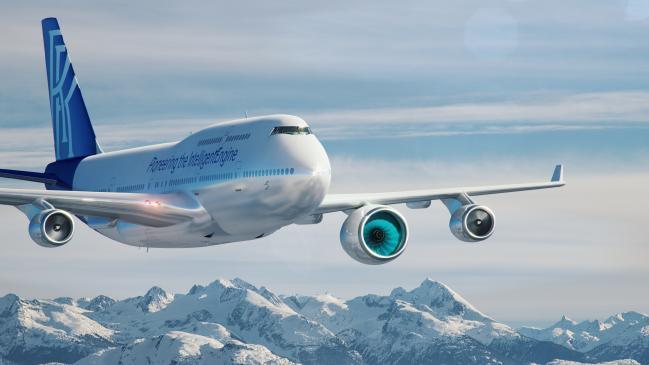
VH-OJU in its proposed testing scheme. (Rolls Royce Image)
747-438ER Series
VH-OEE 747-438ER c/n 32909-1308.
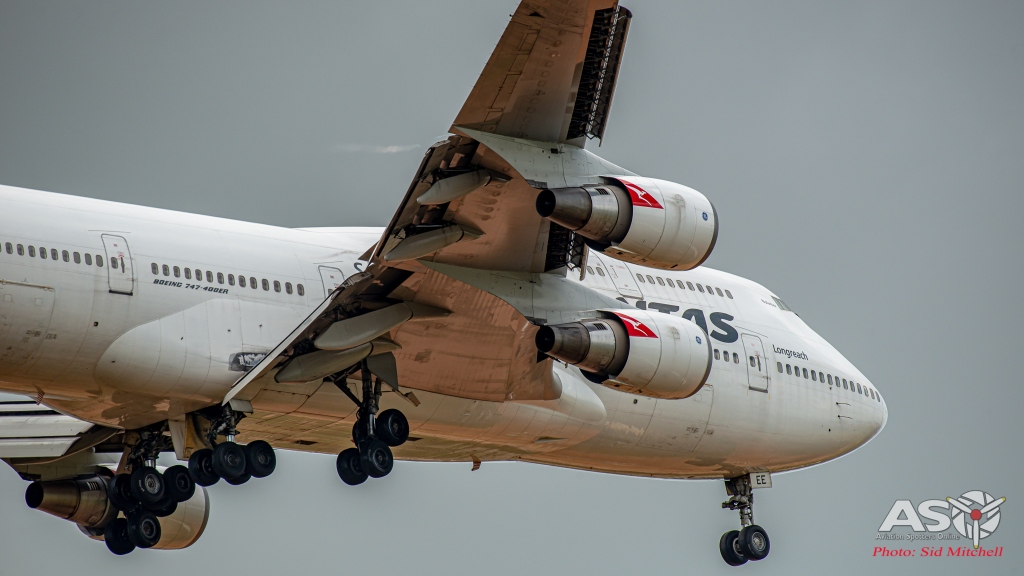
Boeing 747-438(ER), VH-OEE, as QF6032 arriving at Darwin International Airport around 11:40am local time after the 6 hour flight from China, with 313 crew, passengers and medical staff on board.

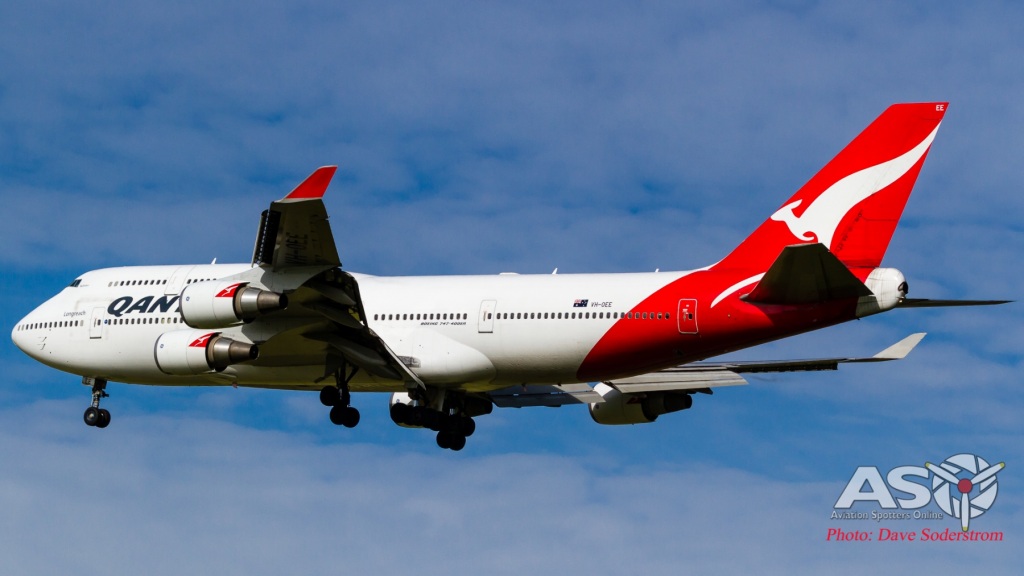
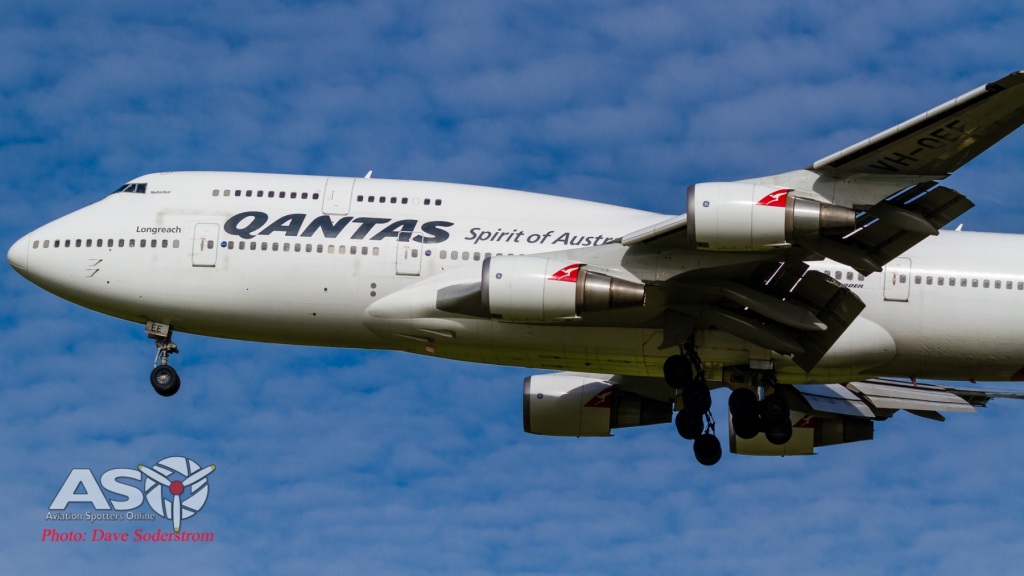
VH-OEF 747-438ER c/n 32910-1313.


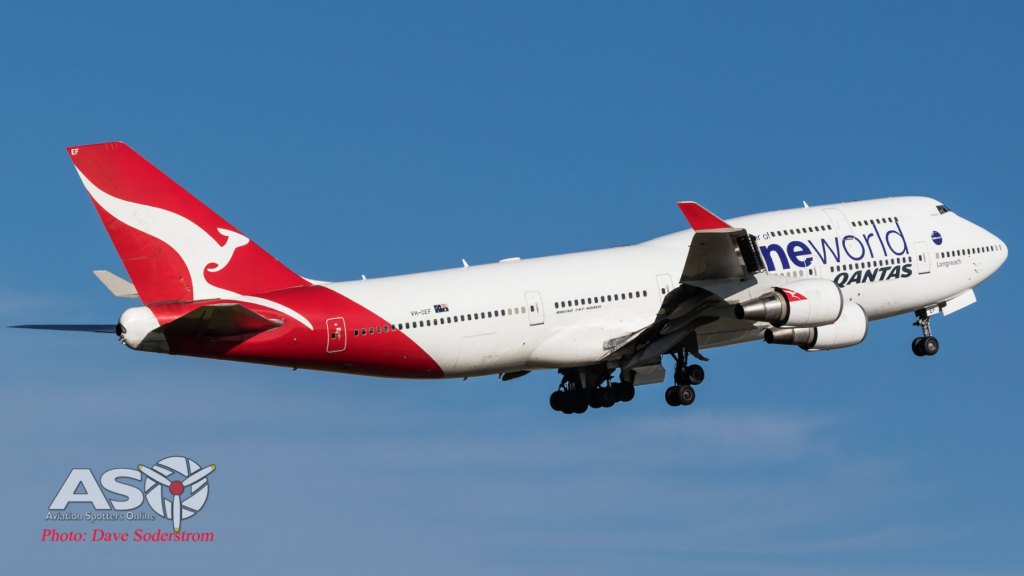
VH-OEG Boeing 747-438ER c/n 32911-1320.



Qantas 747-438ER, VH-OEG as QF29 FL360 at 467Kts over Darwin
VH-OEH 747-438ER c/n 32912-1321.
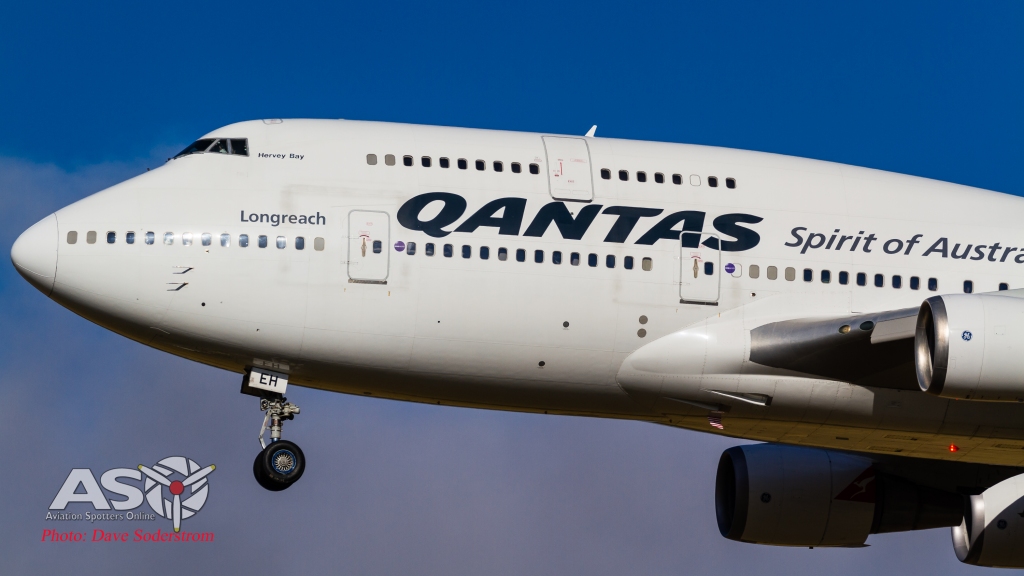

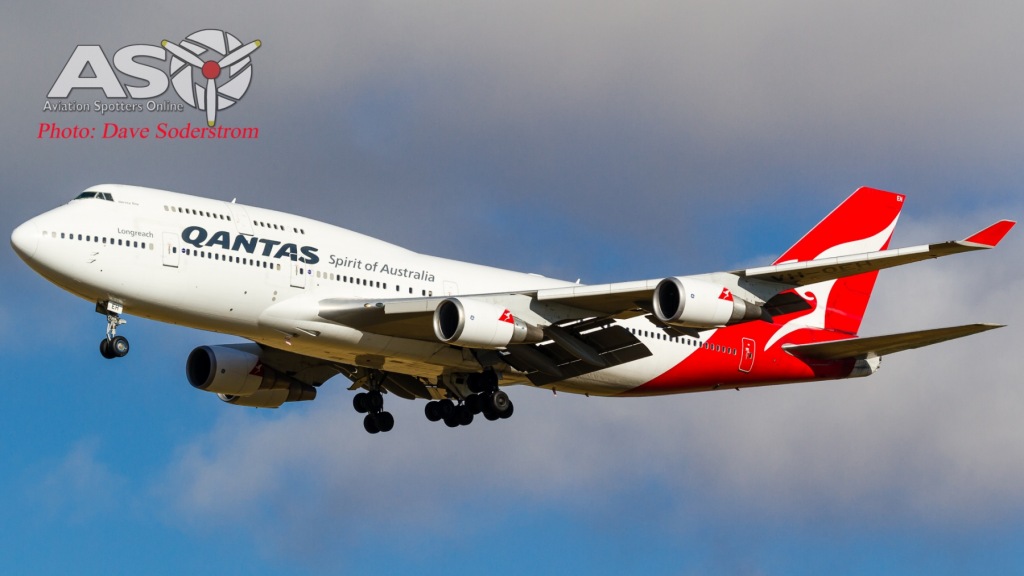
VH-OEI 747-438ER c/n 32913-1330.

VH-OEJ 747-438ER c/n 32914-1331.

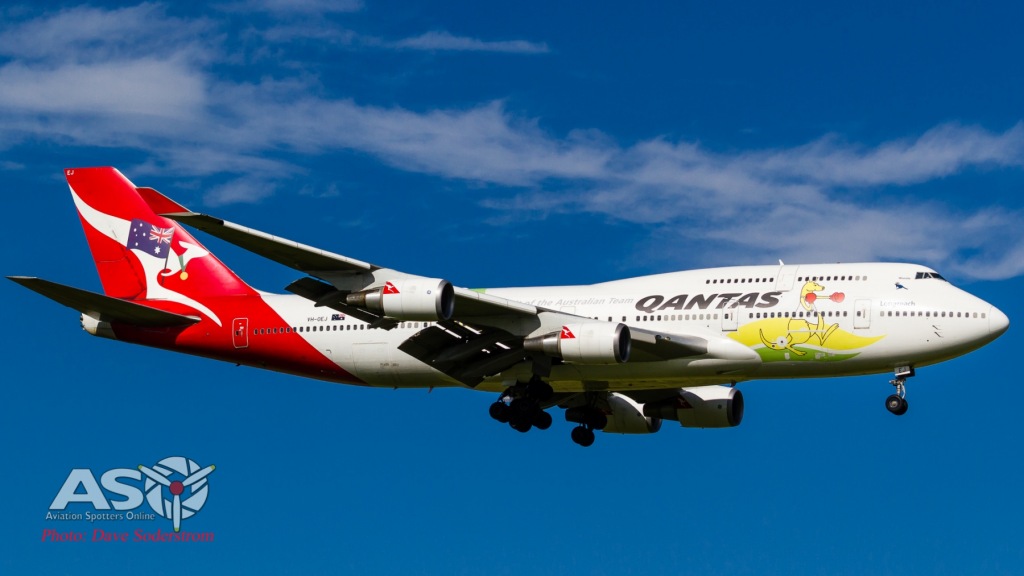
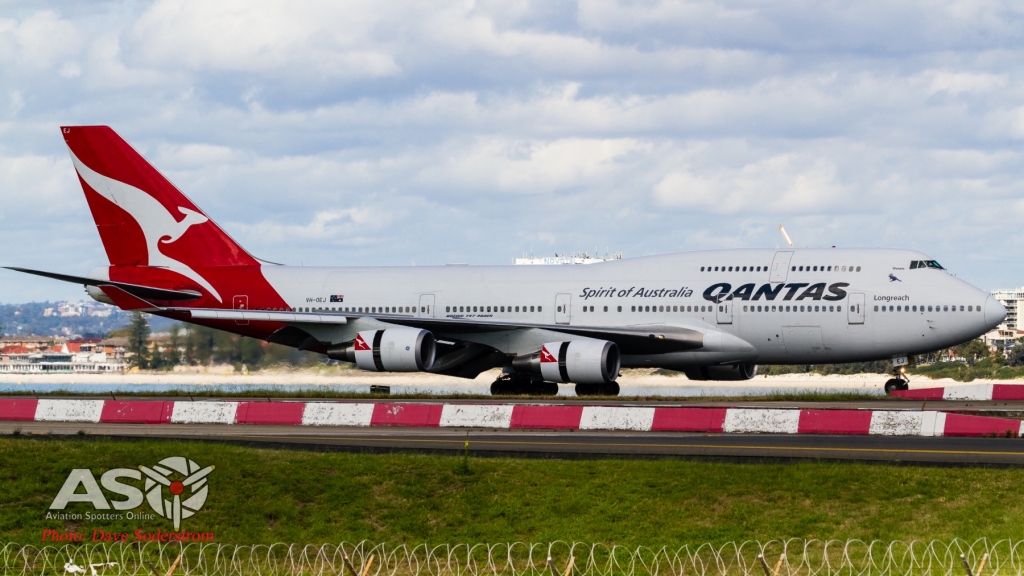
QANTAS 747s on display in Australia
QANTAS has three of its 747s on display and persevered around Australia. Ironically it’s one of each of the 238, 338 and 438 series.
The first to go into preservation at the home of QANTAS, Longreach Queensland was VH-EBQ. The QANTAS Founders Museum at Longreach is home to this 747-238 which had flown 92,125 hours with 18,020 cycles when it operated its final flight from Sydney to Longreach as QF6191 on November 11, 2002. The aircraft is available for wing walking tours and a behind the scenes look at the inner workings of the 747. The museum has built a large roof over it the 707, Constellation, Catalina, and DC-3 which are all on display within the museum grounds.
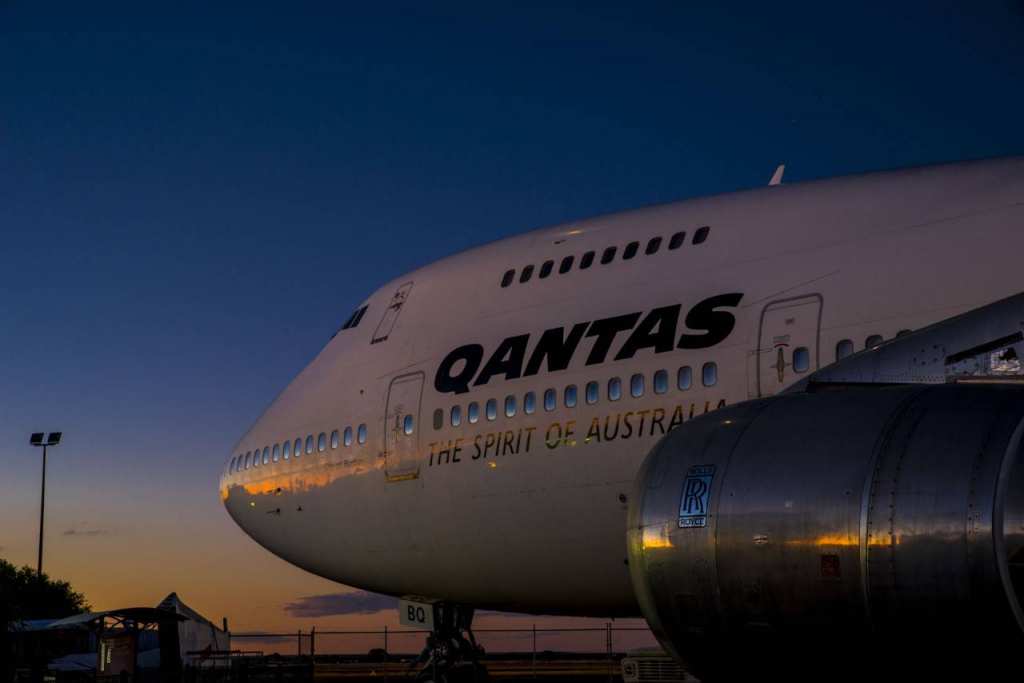
VH-EBQ proudly displays its QANTAS titles. (Image from QANTAS Founders Museum)
The second example which isn’t on display, has been repurposed for among other things, counter terrorism training is VH-EBU. This Boeing 747-338 was delivered to QANTAS on January 24th 1985. It was the 60th Boeing airliner delivered new to QANTAS Airways. On November 14, 1995 it was rolled out in the spectacular ‘Nalanji Dreaming’ livery. Operating QF6195 – February 01, 2005, it was ferried to Avalon Airport near Geelong in Victoria for long term storage. Today it remains at Melbourne (Avalon) and used for security training and as a movie prop. it has also been painted all-white and now carries ‘Avalon Airport’ titles. We can only hope that this airframe becomes a museum piece once the time comes for a new role. It would be sad to see the only 747-338ER in Australia scrapped.

The third aircraft is probably one of QANTAS’s most historic 747’s. VH-OJA, was the first of an initial Qantas order for eighteen and unlike the other two launch customers, the engines chosen were the Rolls Royce RB-211. The airframe was the first Qantas 747-438, and the twelfth -400 produced, accepted by the airline on the 11th August 1989 and called “City of Canberra”. The aircraft holds the world record for the longest non-stop flight by a commercial aircraft – London to Sydney in August 1989 for a total flight time of 20hrs and 9 minutes at an average speed of ~893 km/h for a total distance of ~18,012km. During that flight, there were just 23 passengers and crew and the aircraft used a special blend of high density fuel to enable it fly the record distance. The extra fuel density enabled about an extra ten tonnes of fuel, increasing capacity to about 183 tonnes for the flight.
The City of Canberra was in service for 25.3 years, flew 13,833 flights, carried 4,094,568 passengers and had flown nearly 85 million kilometres.
The aircraft was acquired by the Historical Aircraft Restoration Society (HARS) acquired on 8 March 2015 as a gift from QANTAS after the airline cancelled a plan to retire her to the ‘aircraft graveyard’ in Victorville, California and instead donated the historic aircraft to HARS to be preserved.
Her final flight from Sydney to Illawarra Regional Airport was just 12 minutes, the shortest delivery flight by a QANTAS 747. The flight was several months in planning including the pilots spending more than 25 hours in a flight simulator in preparation. The arrival was watched by tens of thousands of people gathered at all vantage points around the airport.
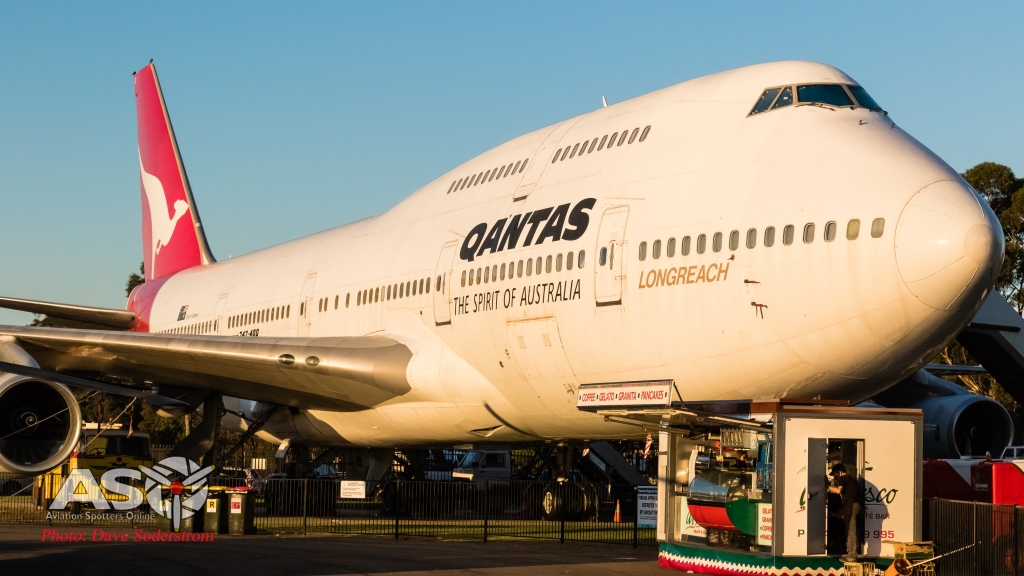
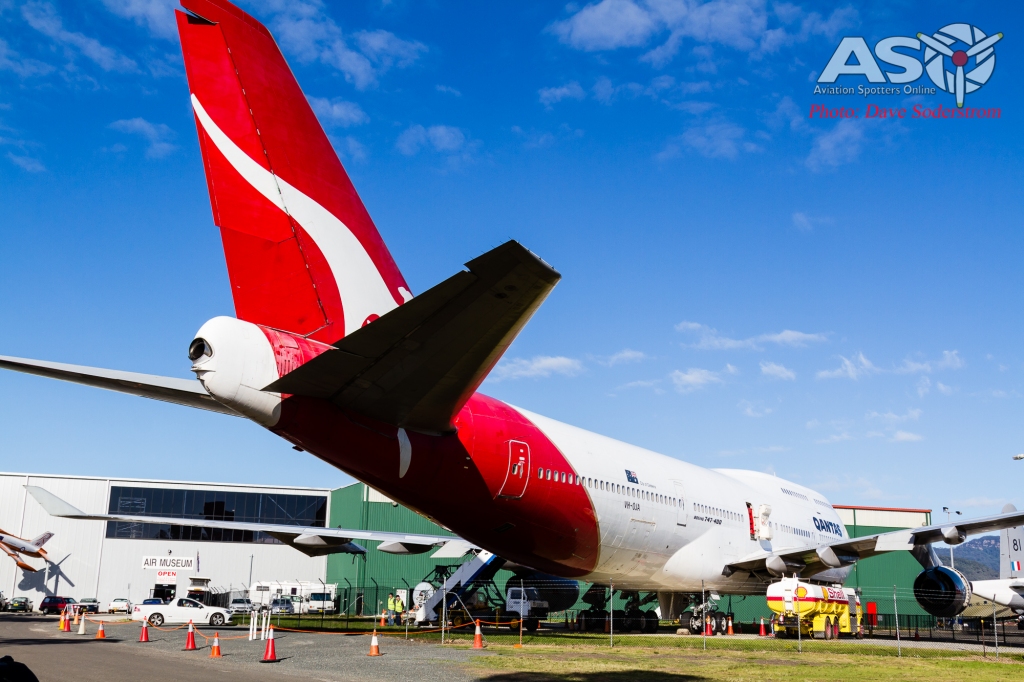



QANTAS 747 Memorabilia
As mentioned previously the 747 is a real favourite of mine. To the point where I have collected lots of memorabilia from the type over the years. From models to safety cards, and everything in between including business class seats they all form part of a collection of history from they type in QANTAS service.


Original 747B (747-238) safety card.

747SP Safety card from the early 90’s
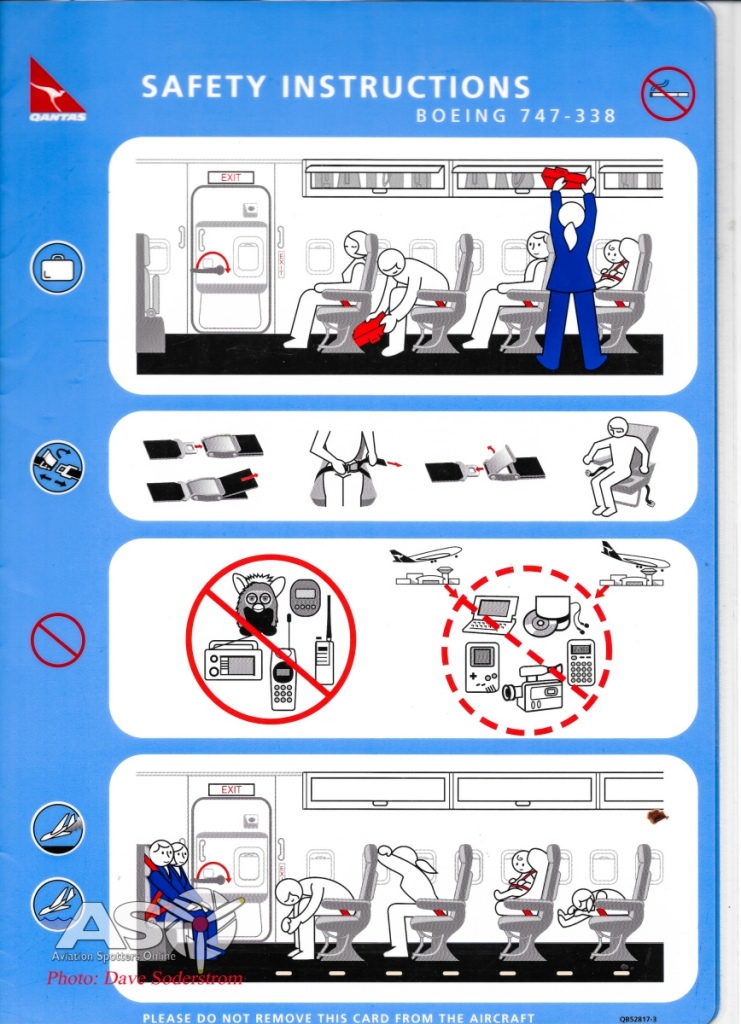
747-338 Safety Card from the early 2000’s
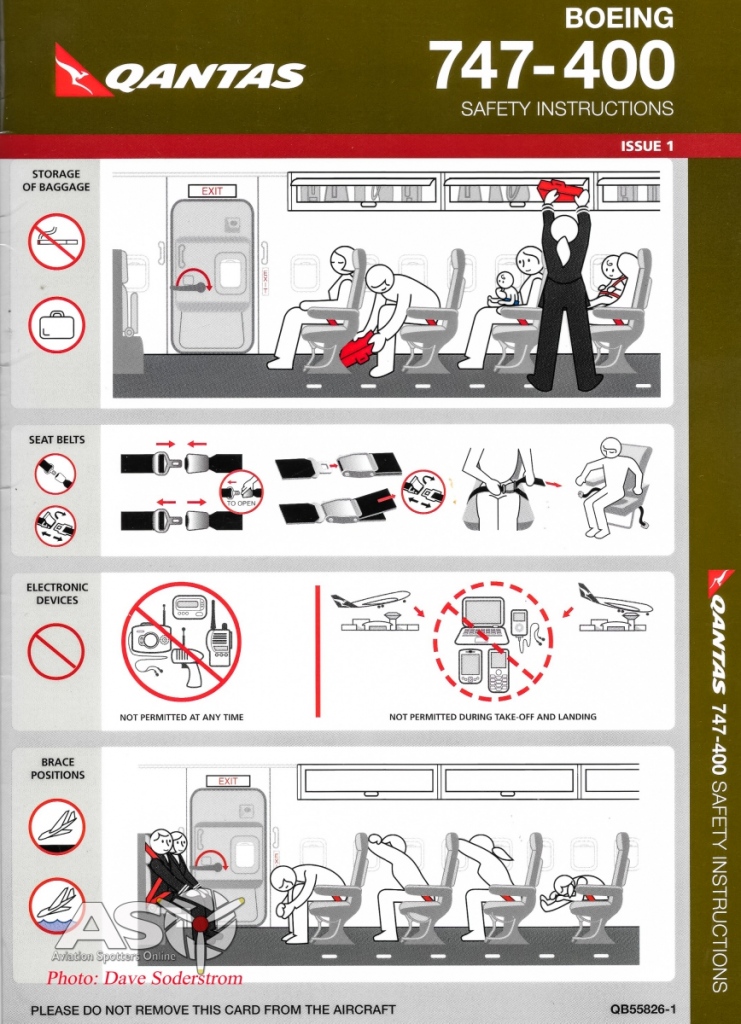
Current 747-438 Safety Card
COVID-19 an early end??
It was something no one expected and no one could image witch would change the very fabric of society. The outbreak of the Coronavirus across the world, shut down all facets of life. Airlines were no exception. QANTAS shut down nearly all of its domestic and international routes.
Several 747 repatriation flights have been operated during Covid-19 on behalf of the Australian Government.
Having overnighted at Hong Kong, QANTAS Boeing 747-438ER VH-OEE positioned to Hong Kong for onward to Wuhan as QF6031 to evacuate Australian citizens from Wuhan.
747-438ER VH-OEE operated a Tokyo Haneda – Darwin evacuation flight as QF6032 for Australian citizens from the Diamond Princess cruise ship which has been affected by coronavirus. The aircraft then positioned Darwin – Sydney, also as QF6032.
Grounding the entire fleet saw what some thought was an early retirement for the 747. VH-OEE operated the final flight and was placed into storage at Sydney after arriving as QF28 from Santiago de Chile. On April 10, VH-OEG positioned to Los Angeles and then onto Mojava Air and Space Port as QF6001.
Withdrawn VH-OEH positioned Sydney – Los Angeles on May 19th as QF6001.
What happens next in the life of the 747 in QANTAS’s fleet will depend on demand and when International air travel resumes.
Currently the airline has the aircraft stored in flyable hold. This means that the aircraft can be returned to service at a short turn around should they be required.
Amendment 22/7/20
Qantas formally retired the 747 from its fleet on the 22/7/20. With VH-OEJ operating a set of flights from Sydney, Brisbane and Canberra for fans of the type.
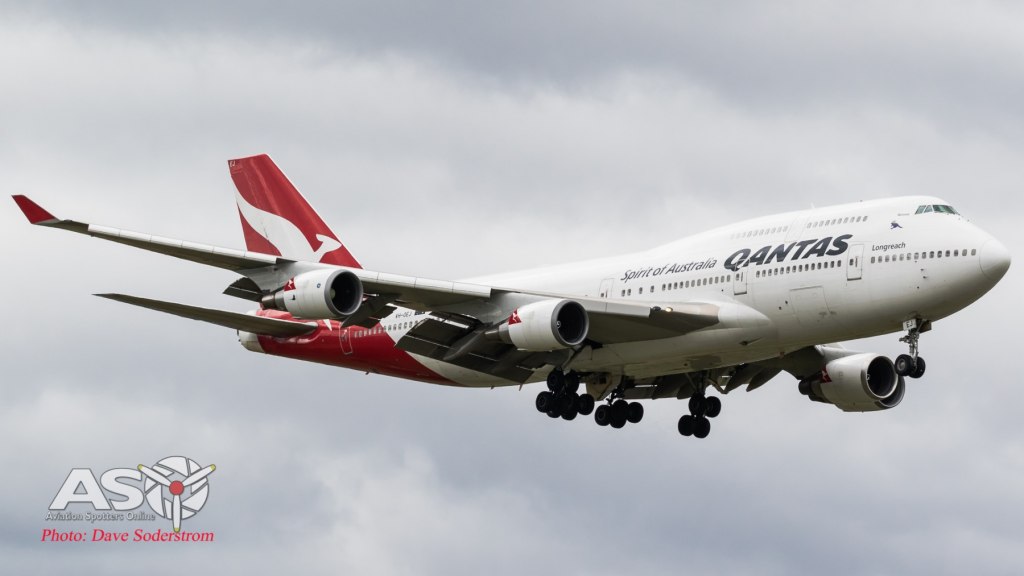
QF7474, the last ever QANTAS 747 passenger flight, started its final flight out of Sydney at 2pm local time flying over the Harbour Bridge, the city’s CBD, northern and eastern suburb beaches as well as the HARS Museum in Albion Park.
A final salute was preformed by the crew with a flying kangaroo flight pattern flown, just off Sydney, a worthy signing off for the type.
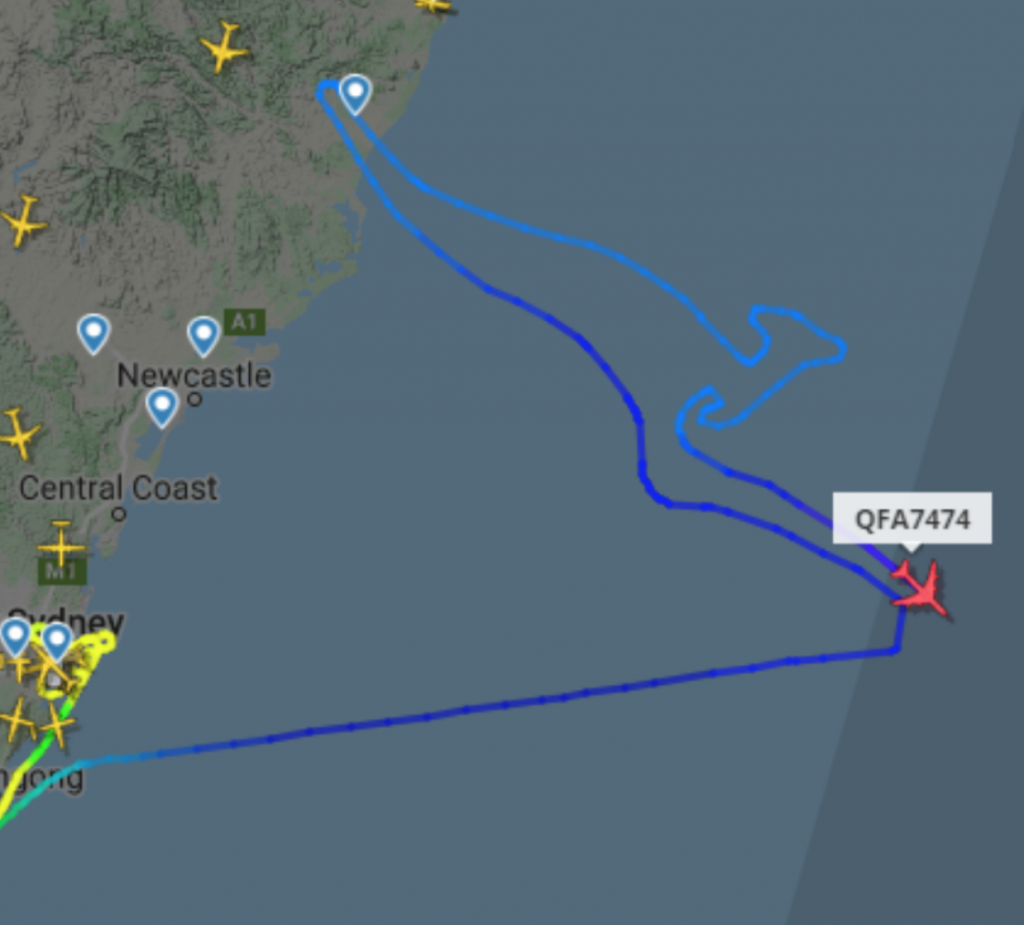

The future for the 747 in QANTAS?
While not being strictly QANTAS aircraft, Atlas Air and QANTAS will continue to operate the 747 in its current 8F variant for cargo operations. This agreement has been in place for sometime with the 747-400F models operating in Australian skies for many years. Two Boeing 747-8Fs, N845GT and N856GT now fly freight for QANTAS to operate between Australia, China, and the USA.
The aircraft retain their Atlas Air livery with the words “Operated by Atlas Air Inc on behalf of Qantas Airways Ltd” on the fuselage alongside the Qantas Freight logo. Atlas Air supplies the aircraft and crew, also the maintenance and insurance, under a wet-lease arrangement. Qantas sells cargo space, with the flights operated under the airline’s QF code.

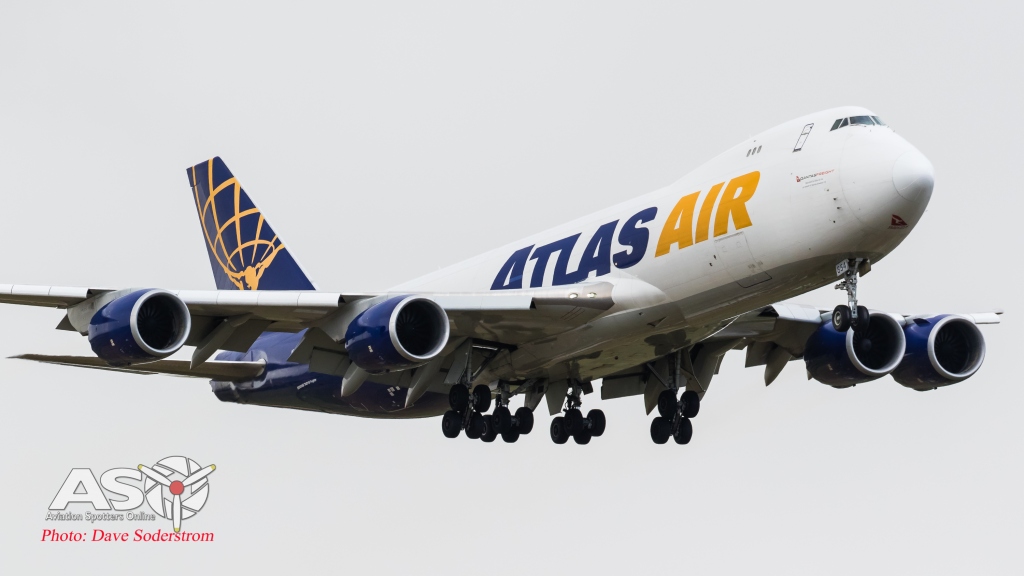
N854GT arrives into Melbourne Airport.
The 747 has a very important place in the history of QANTAS and the Australian airline industry. For its crews, maintainers through to its passengers the 747 will forever be the ‘Queen of the Skies’.
Thanks to QANTAS, Historic Australian Aircraft and the ASO team for the assistance in putting this article together.
Dave Soderstrom

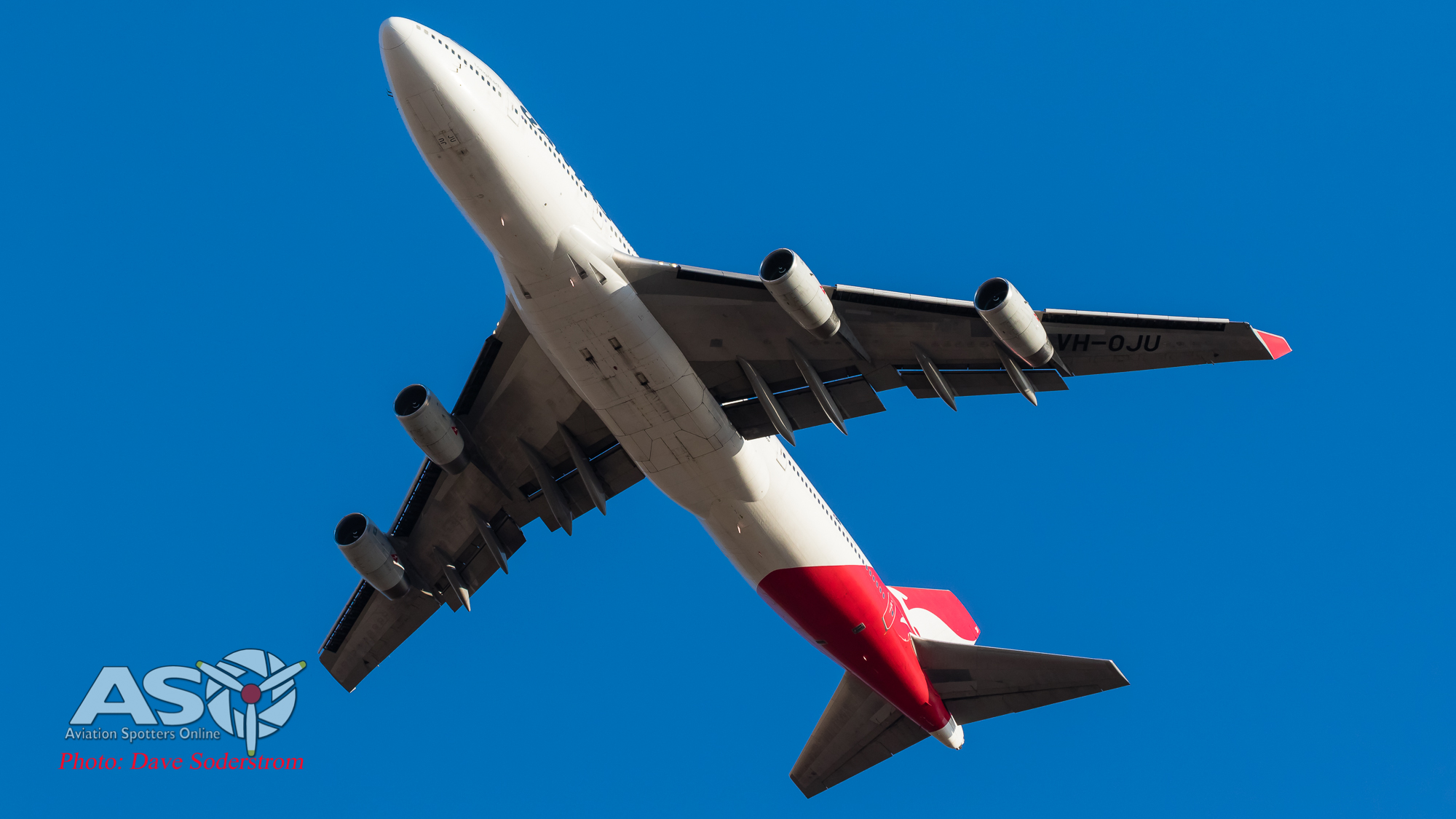
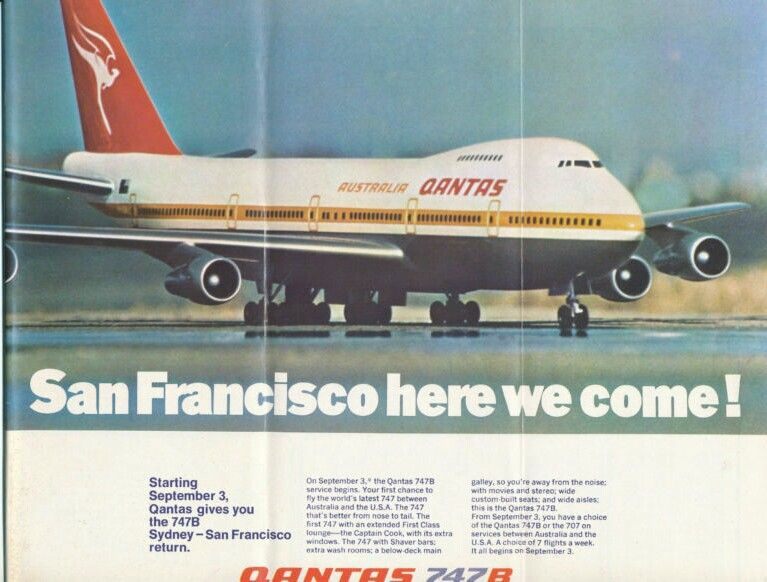

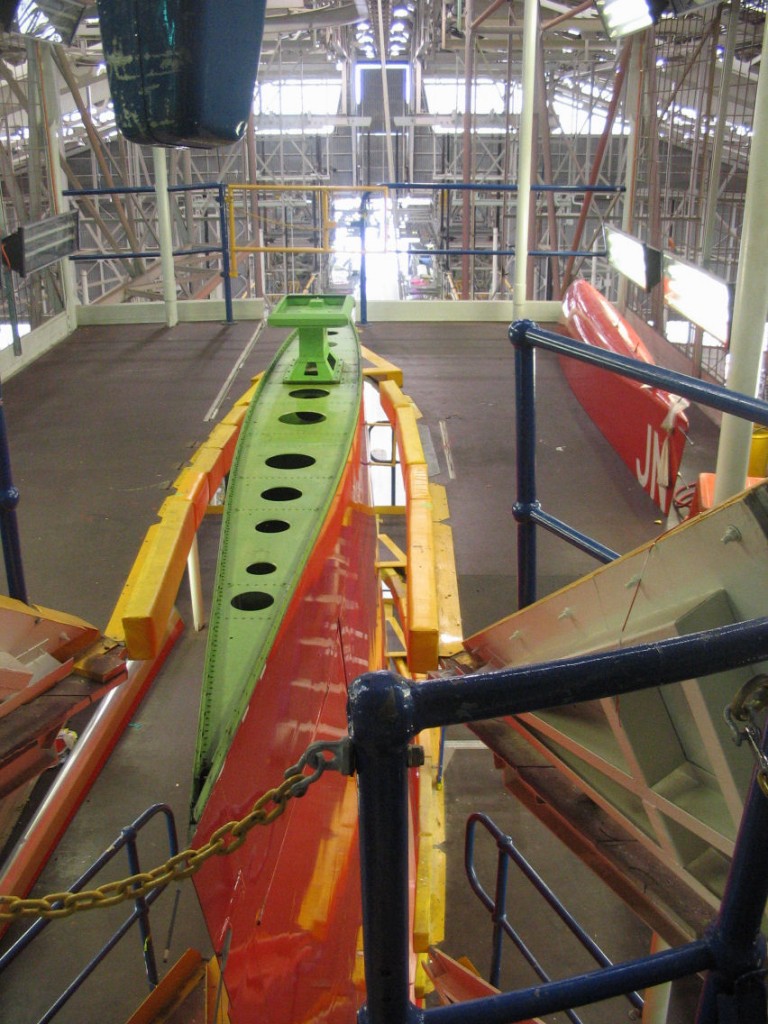
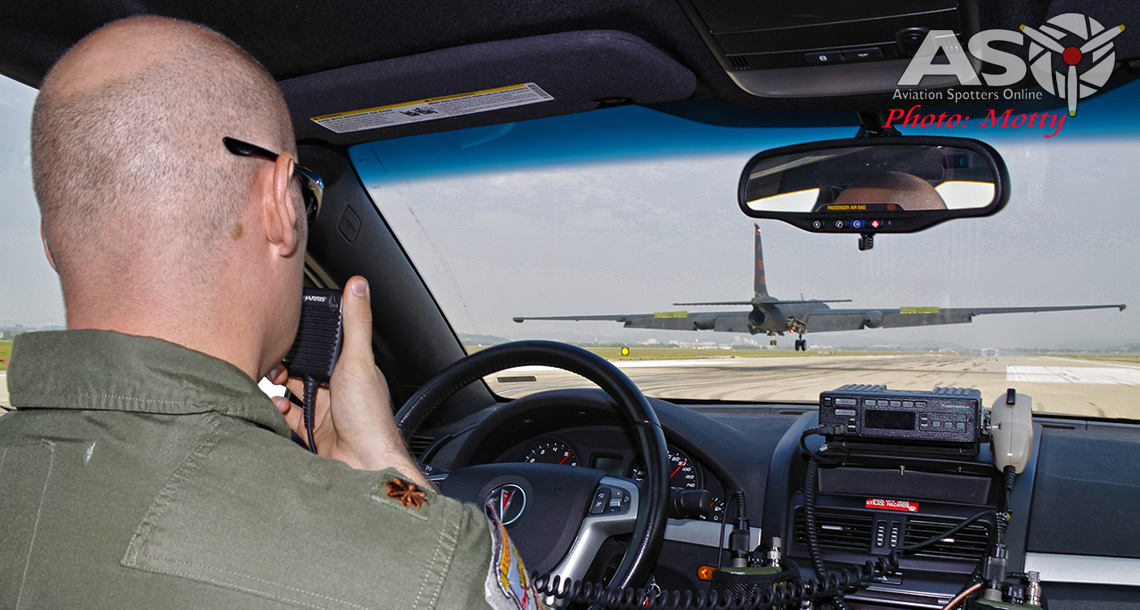
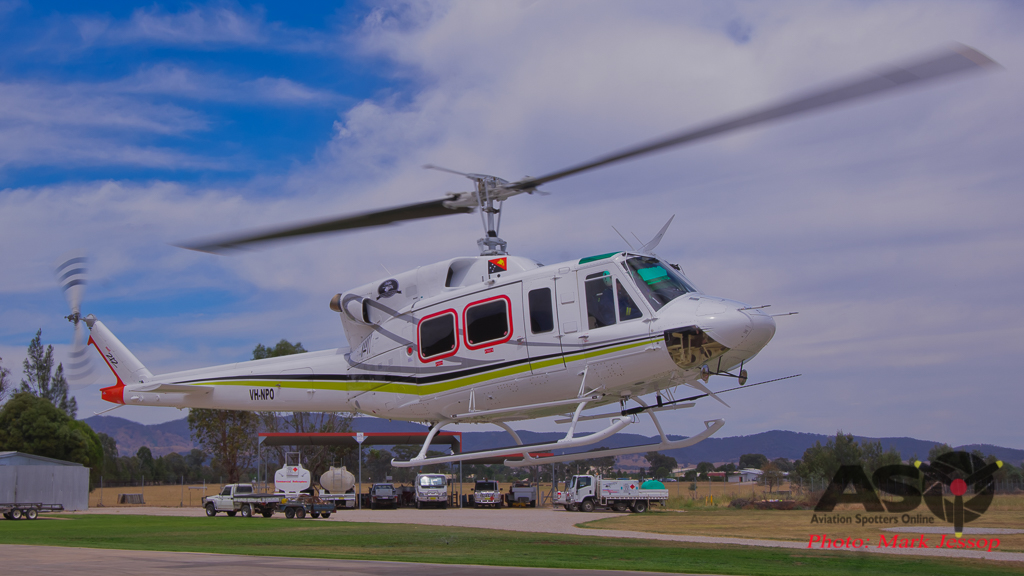







Thank you, great peice much appreciated after the early end to service of the Queen of the Skies with the departure of VH-OEJ at just 17. Still a young bird.
Thanks for the reply Tony. Yes an early retirement for a great aircraft from a great airline. Cheers Dave
Thanks Dave this is Great😀👍🏿✈️
Last flights and ferry flights can come as a surprise.
I flew VH EBU Nalanji Dreaming to Avalon for what was to be a cabin refit and upgrade. There were NO ‘hold’ items in her clean techlog….
But at least she is not scrapmetal as such and lives on in a new and worthwhile role.
Hi Steve, thanks for the feedback. Much appreciated. I’d love to touch base with you for future 747 things if possible. Cheers Dave
Hi Dave
A pleasure!
Drop a line to Boris at my protonmail address👍🏿👨✈️
Thank you Dave for this amazing overview. Being a B747-jockey myself I have fallen in love with the Boeing 747 on my very first flight as a passenger in 1974 and decided back then that I would wanted to become a captain on the jumbo myself once I grew up (yes dreams do come true!).
Too sad to see how CoVid 19 decimates the number of quad engine aircraft around the world. BA has announced a few days ago to retire their B747 fleet prematurely in the wake of the crisis. This will make Lufthansa world´s N°1 operator of B747…but this is only a snapshot of now…wondering how they will hold on to the „Queen of the skies“ if the crisis should last any longer.
Thanks Chris for the great feedback, hope the article does a 747 jock proud. Cheers Dave
I am curious how many passengers have flown the Qantas 747 since 1971 to the last flights….